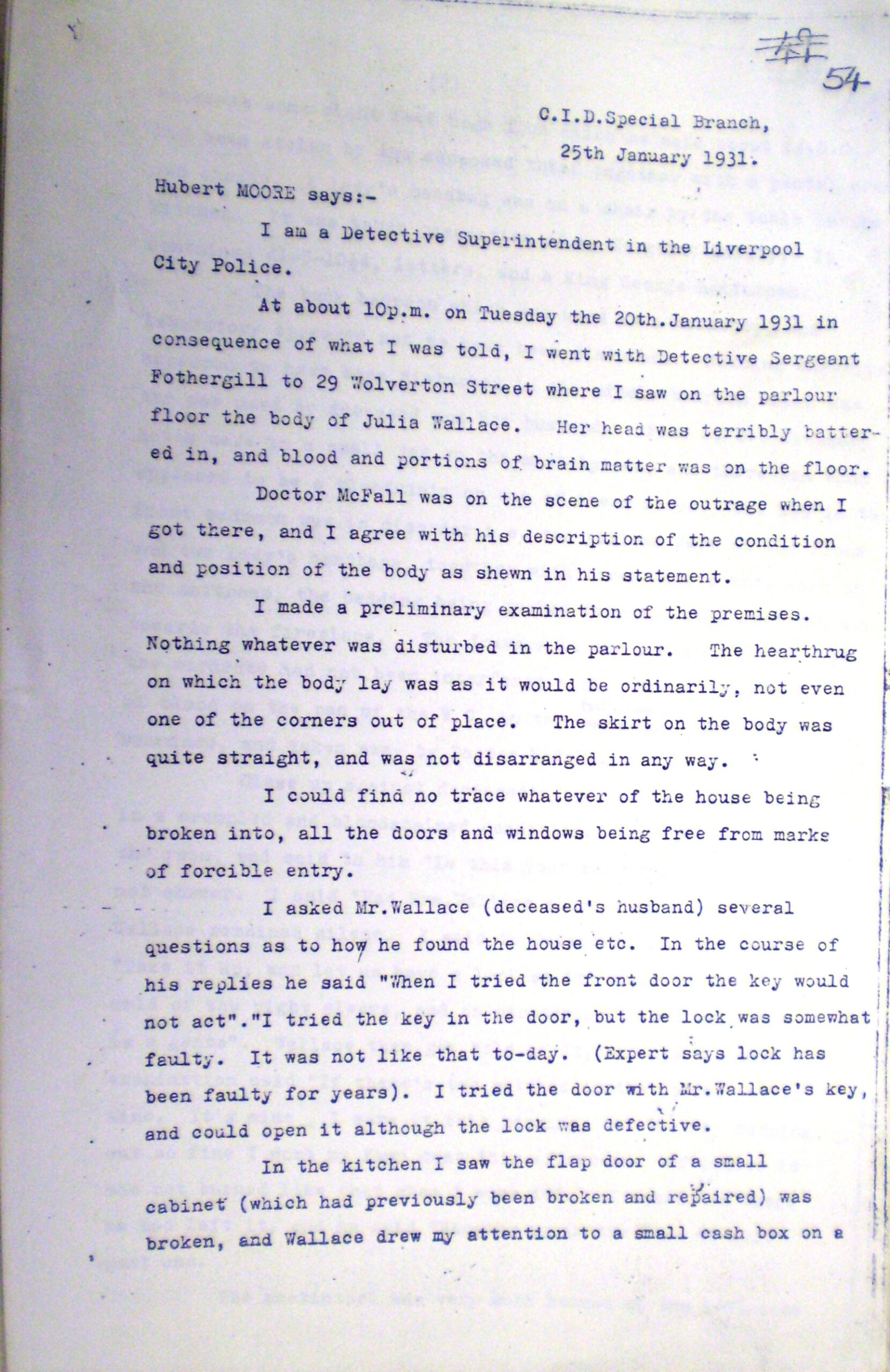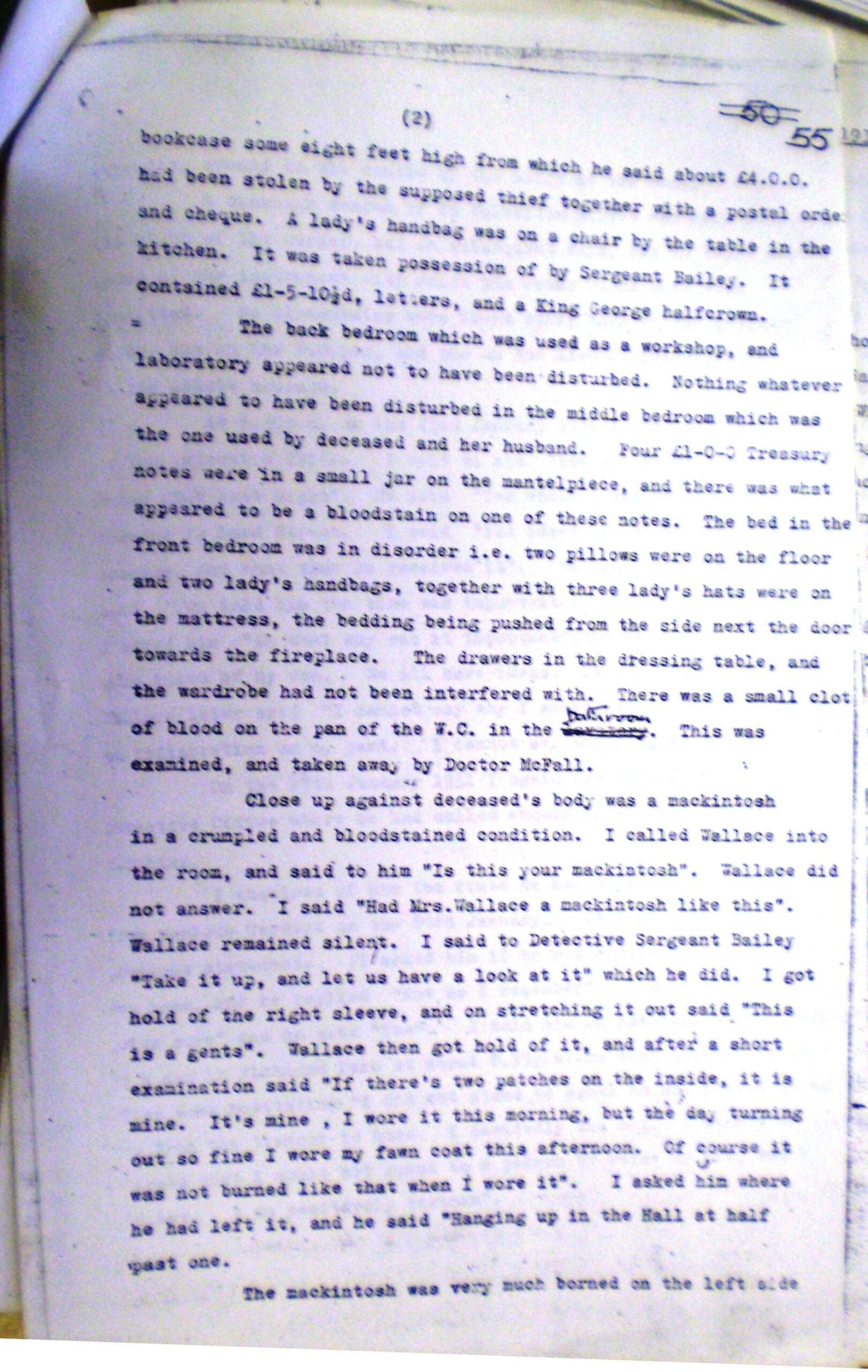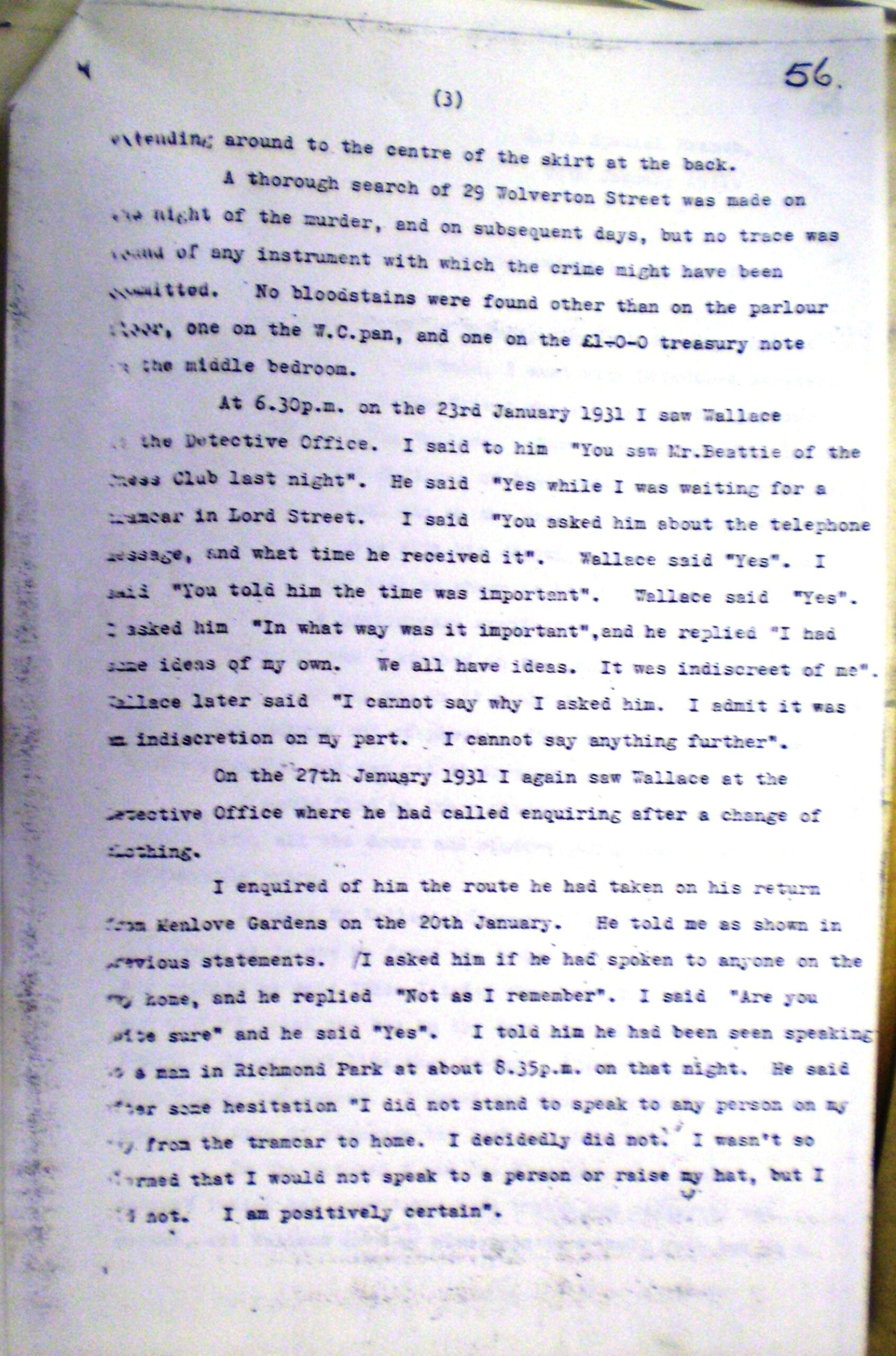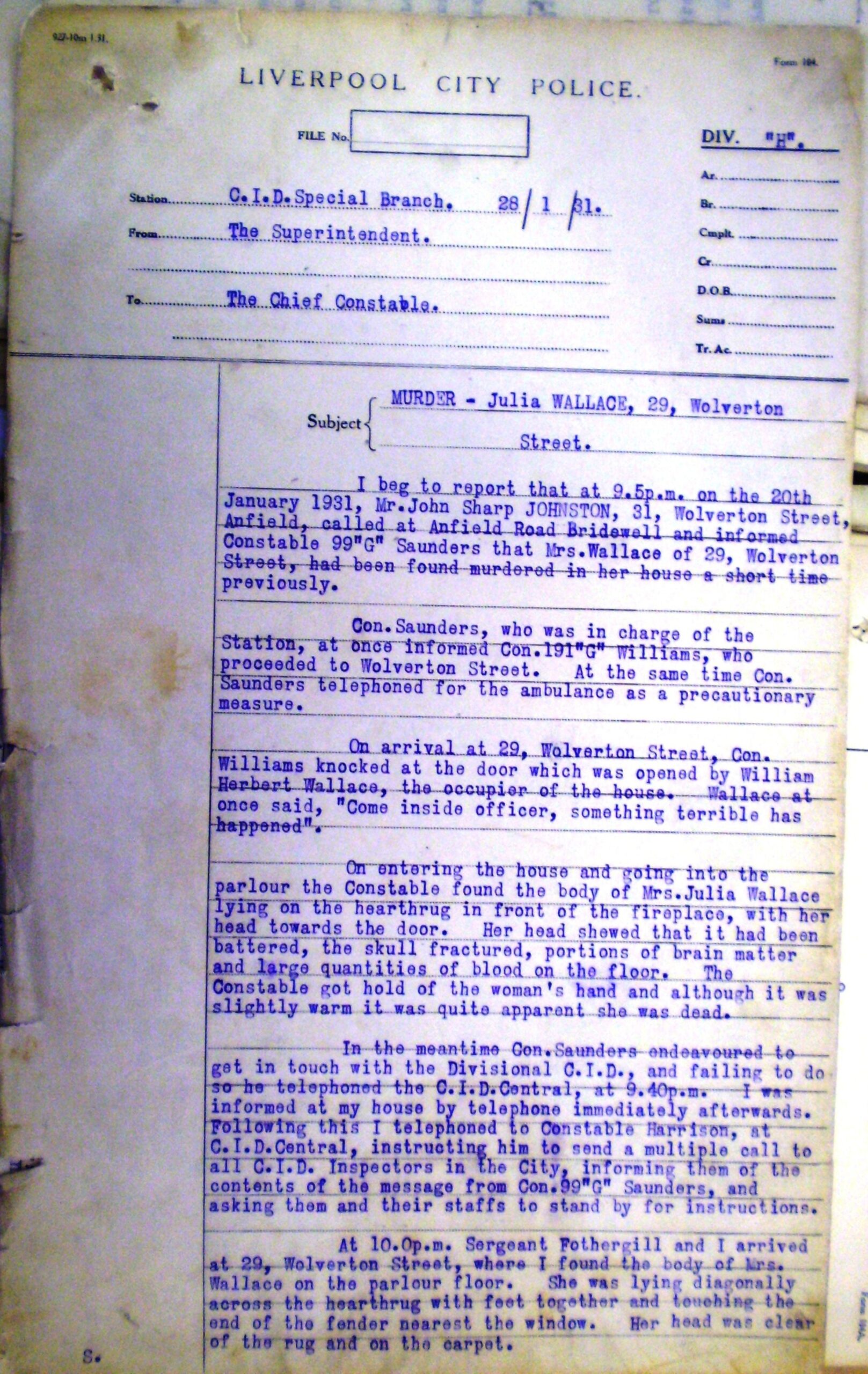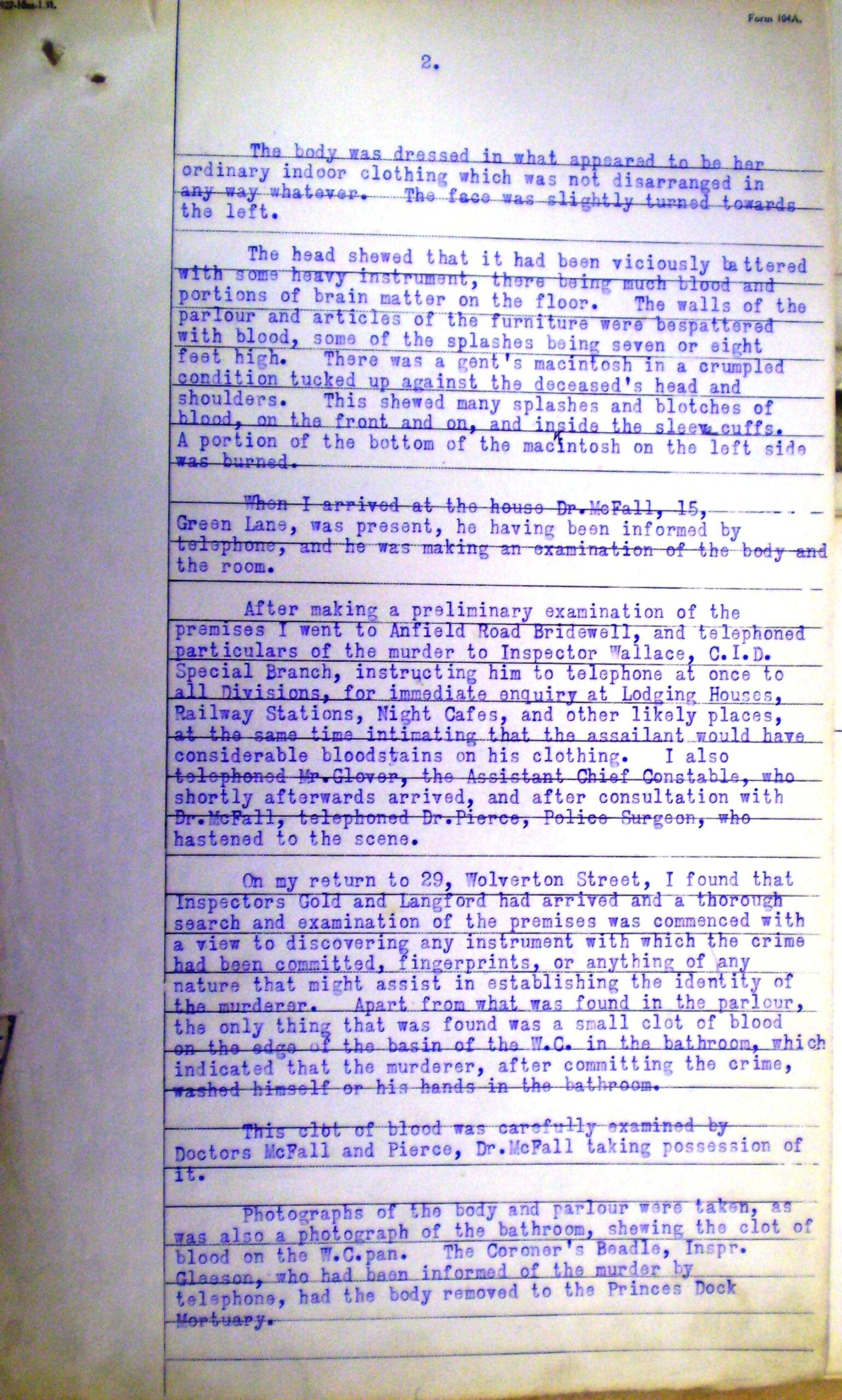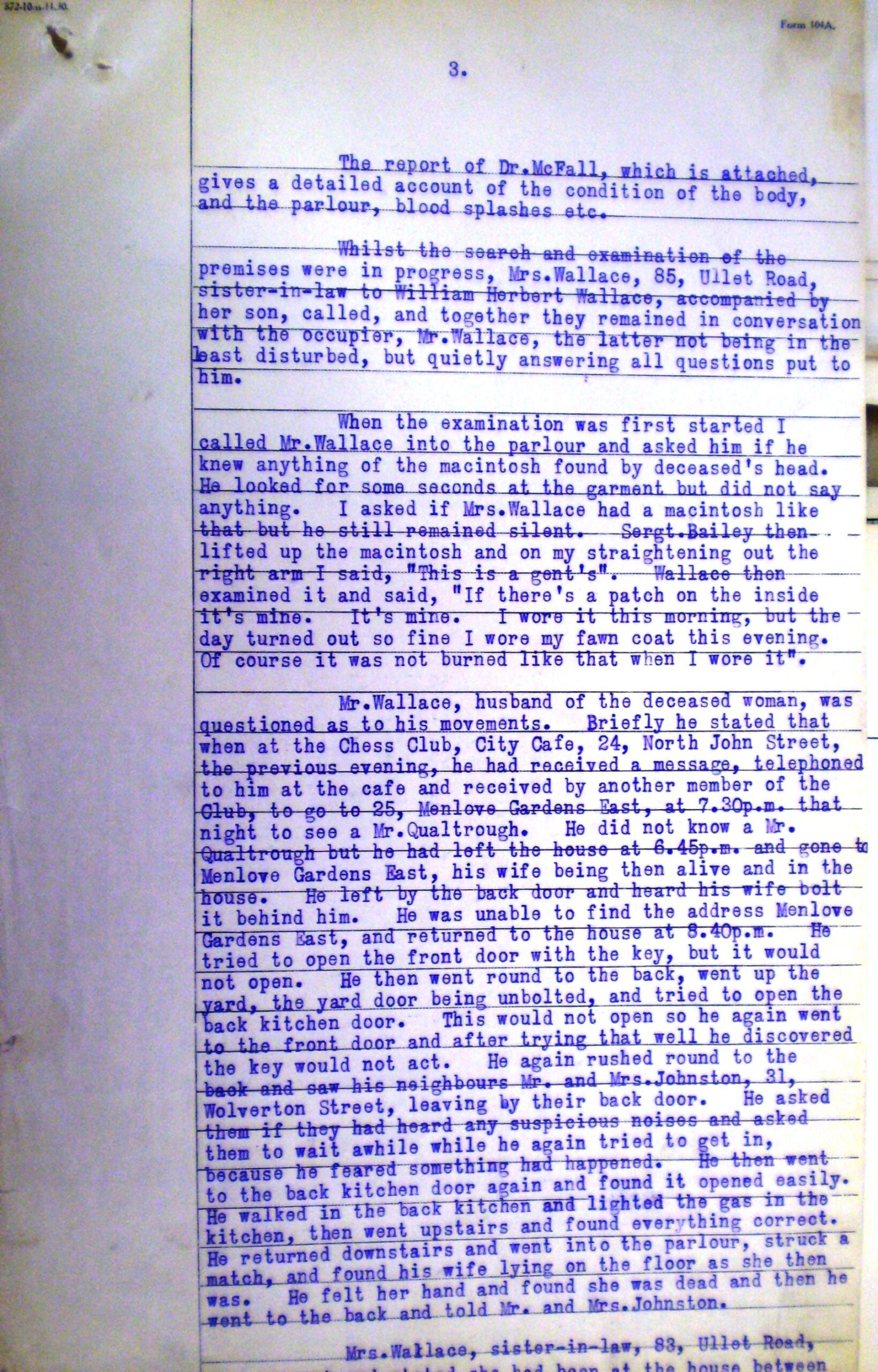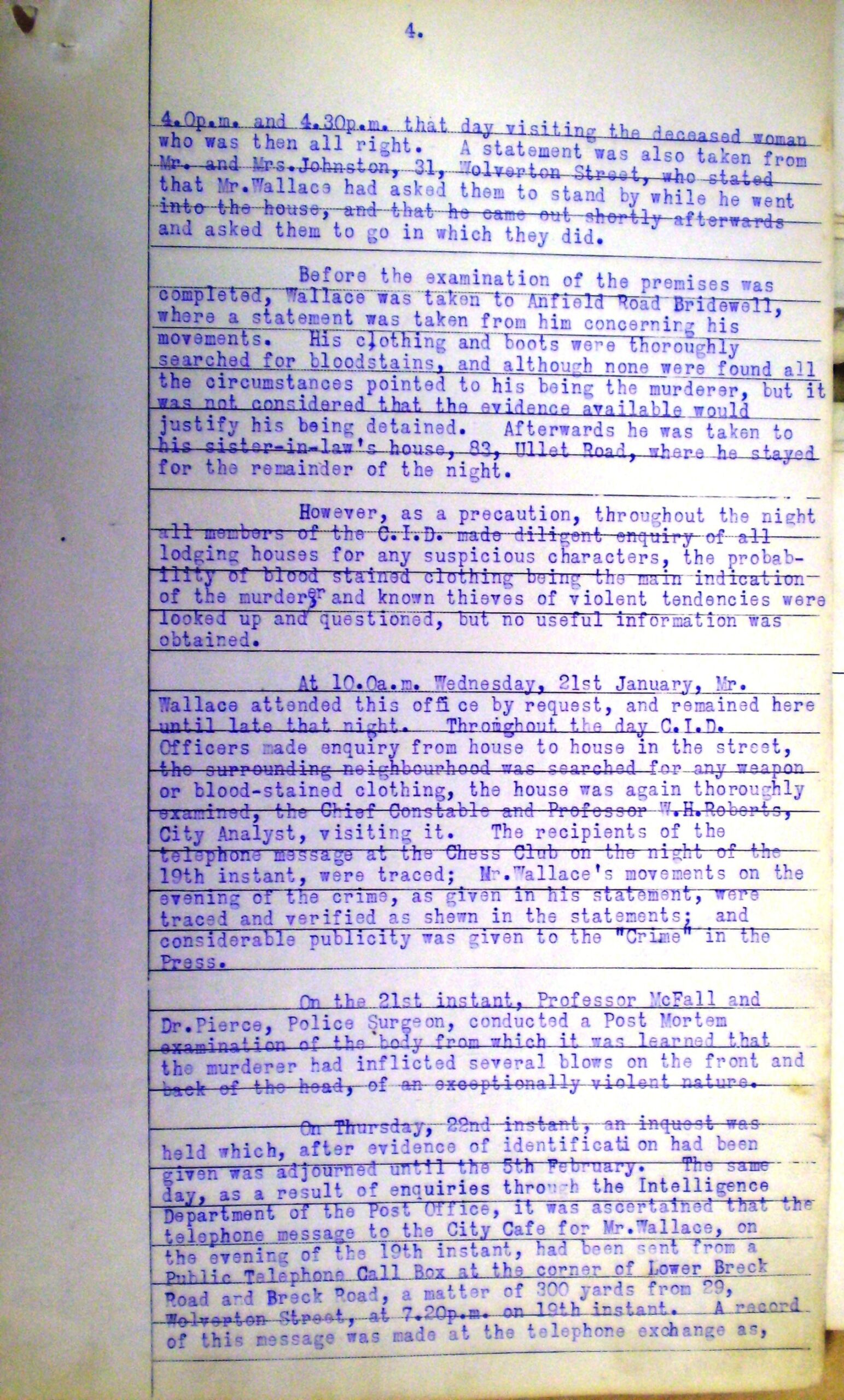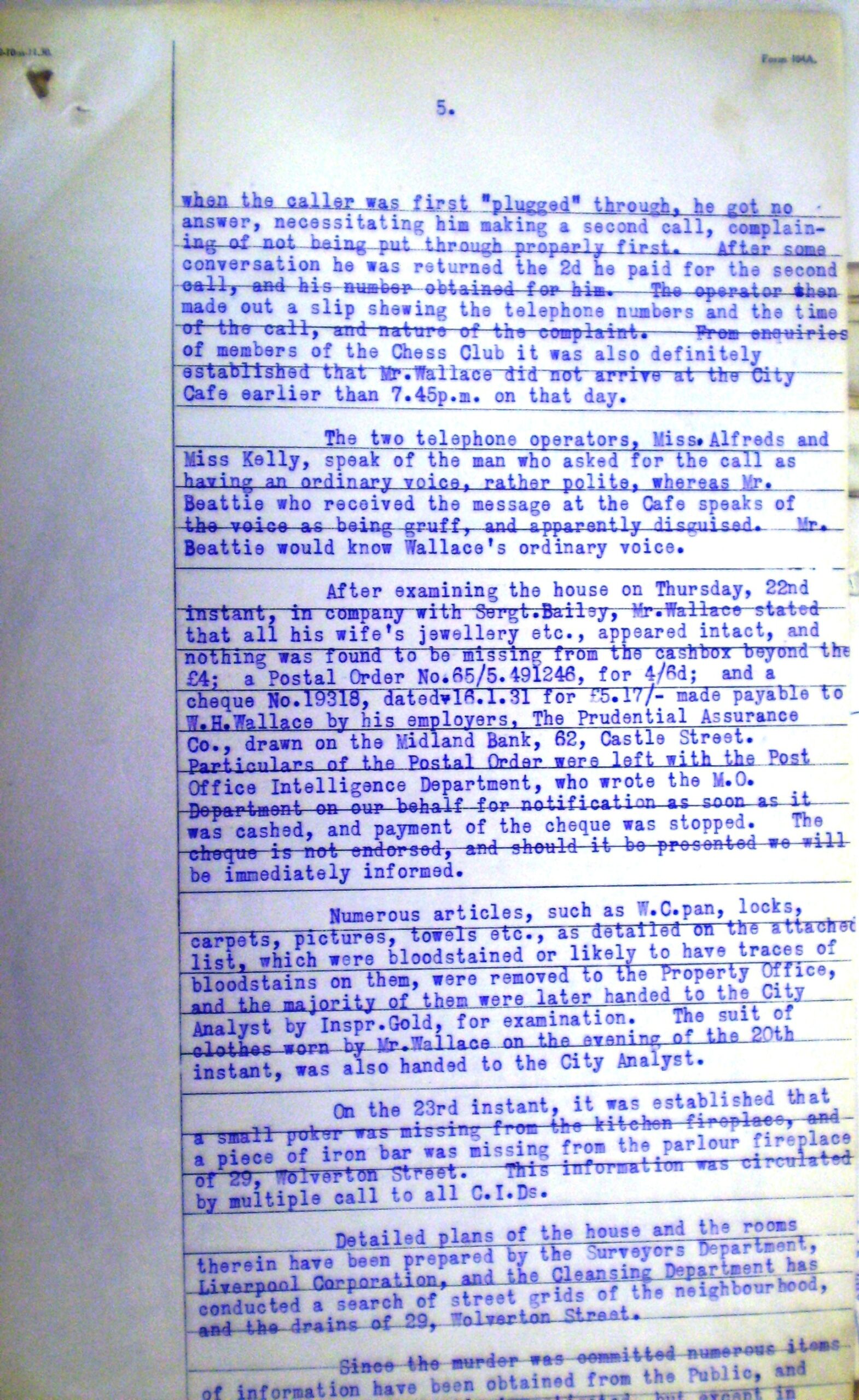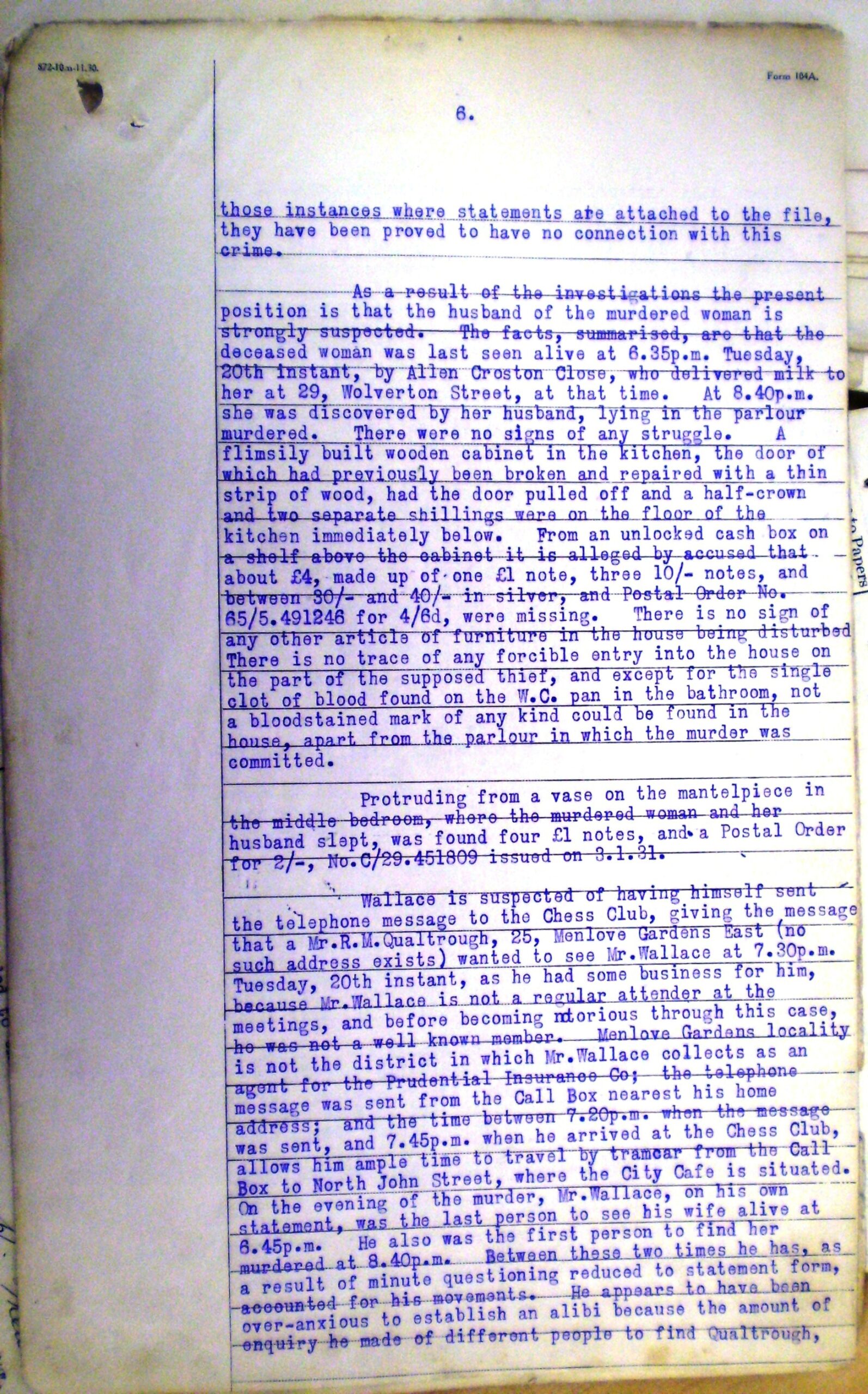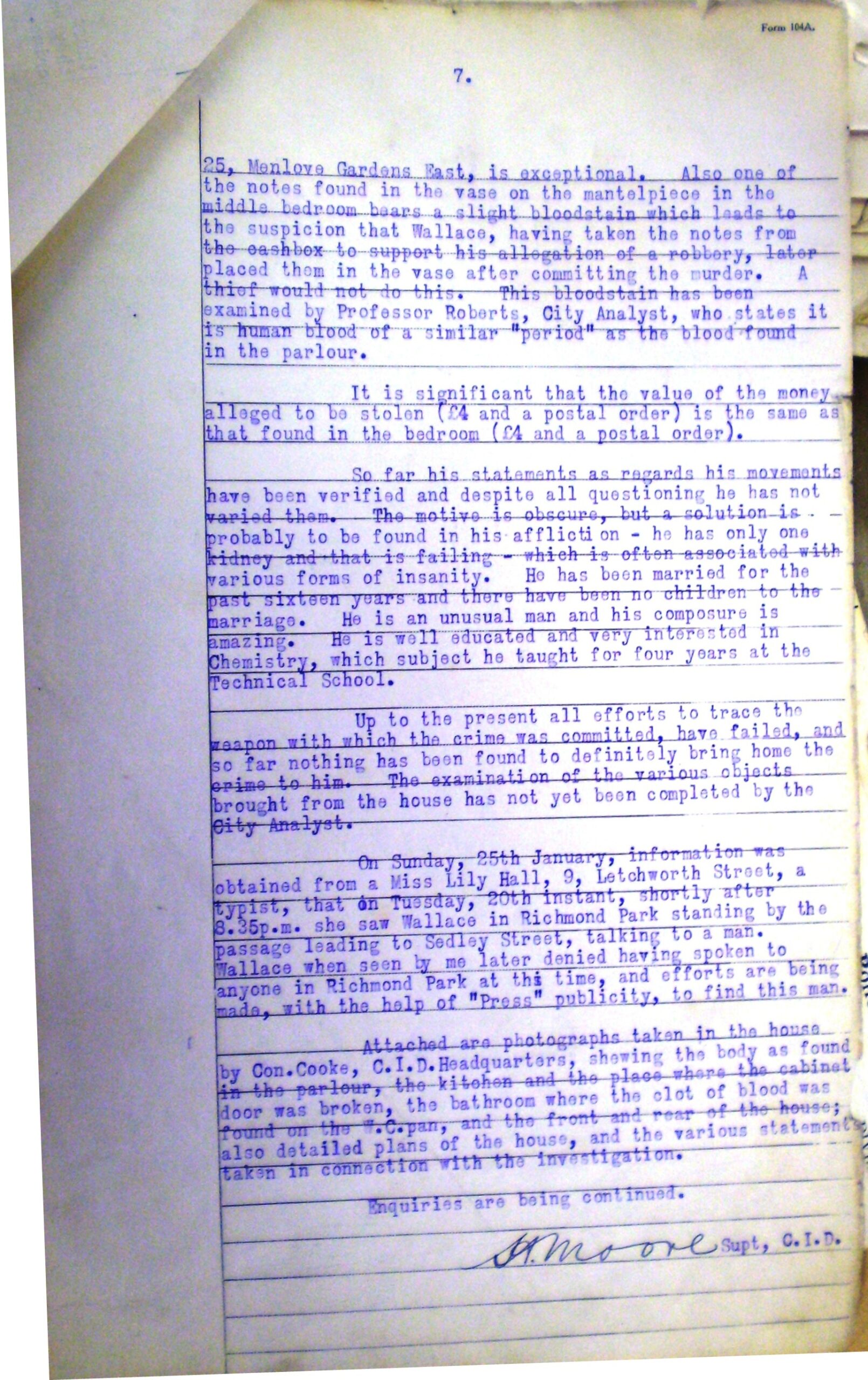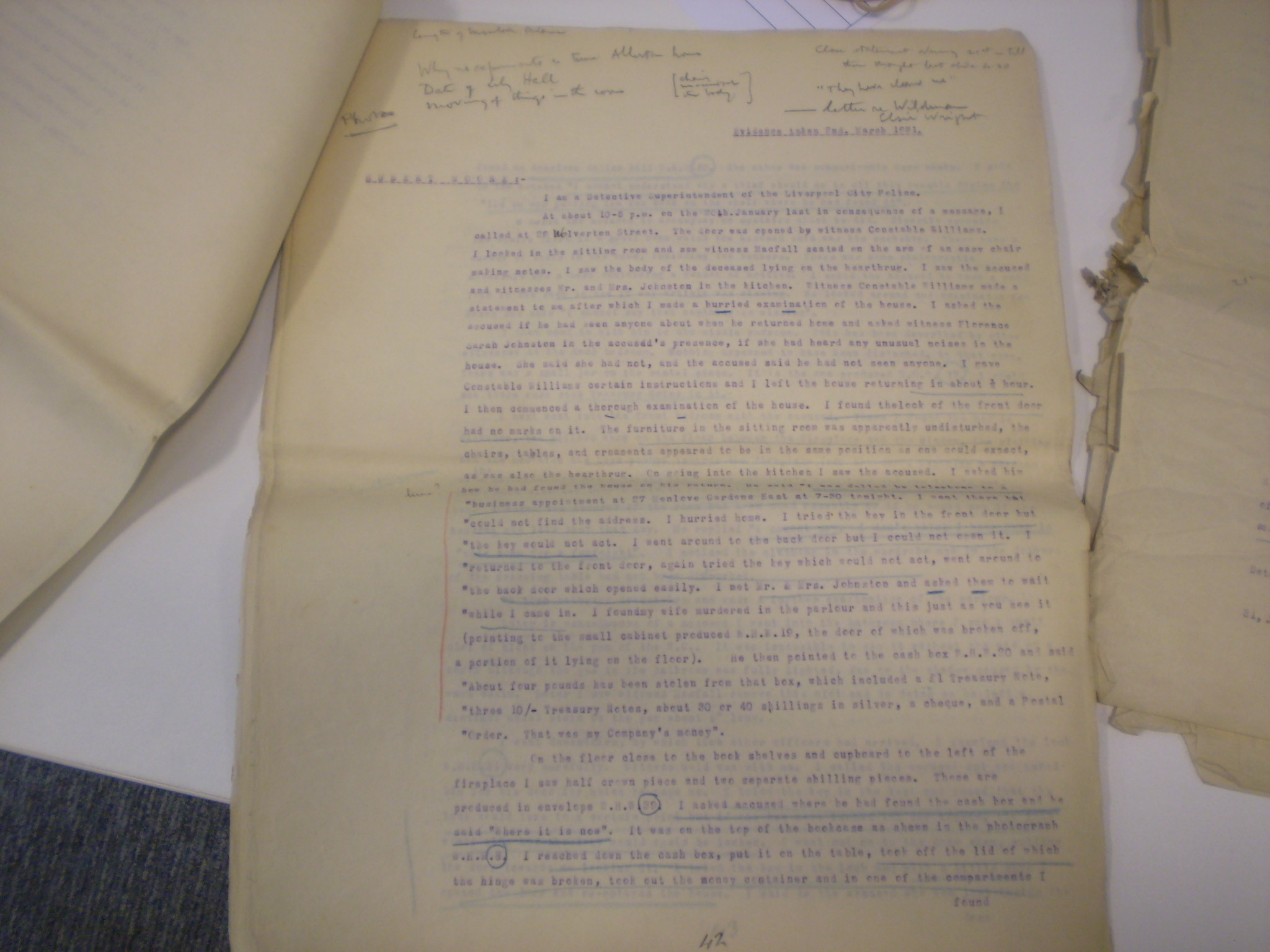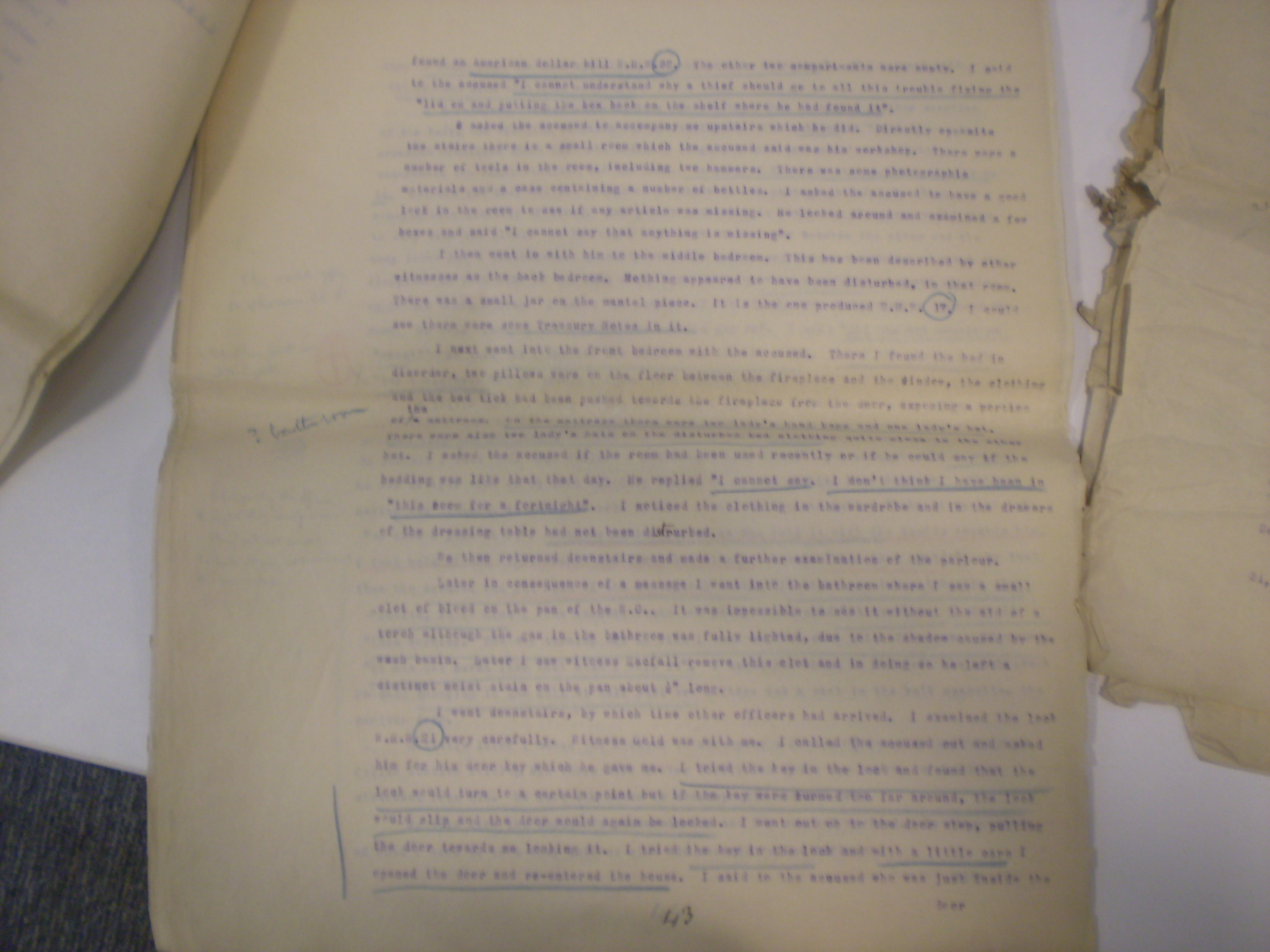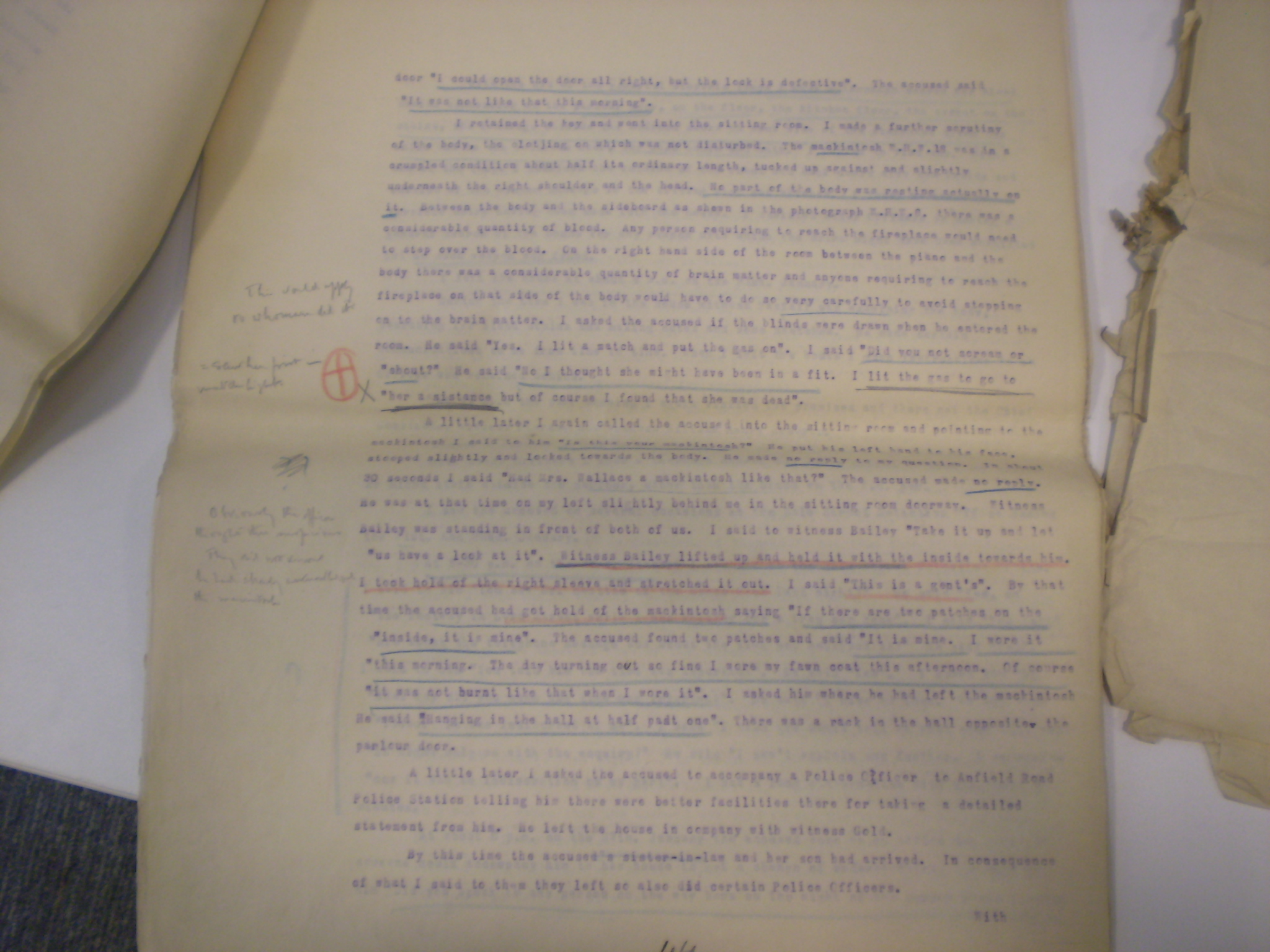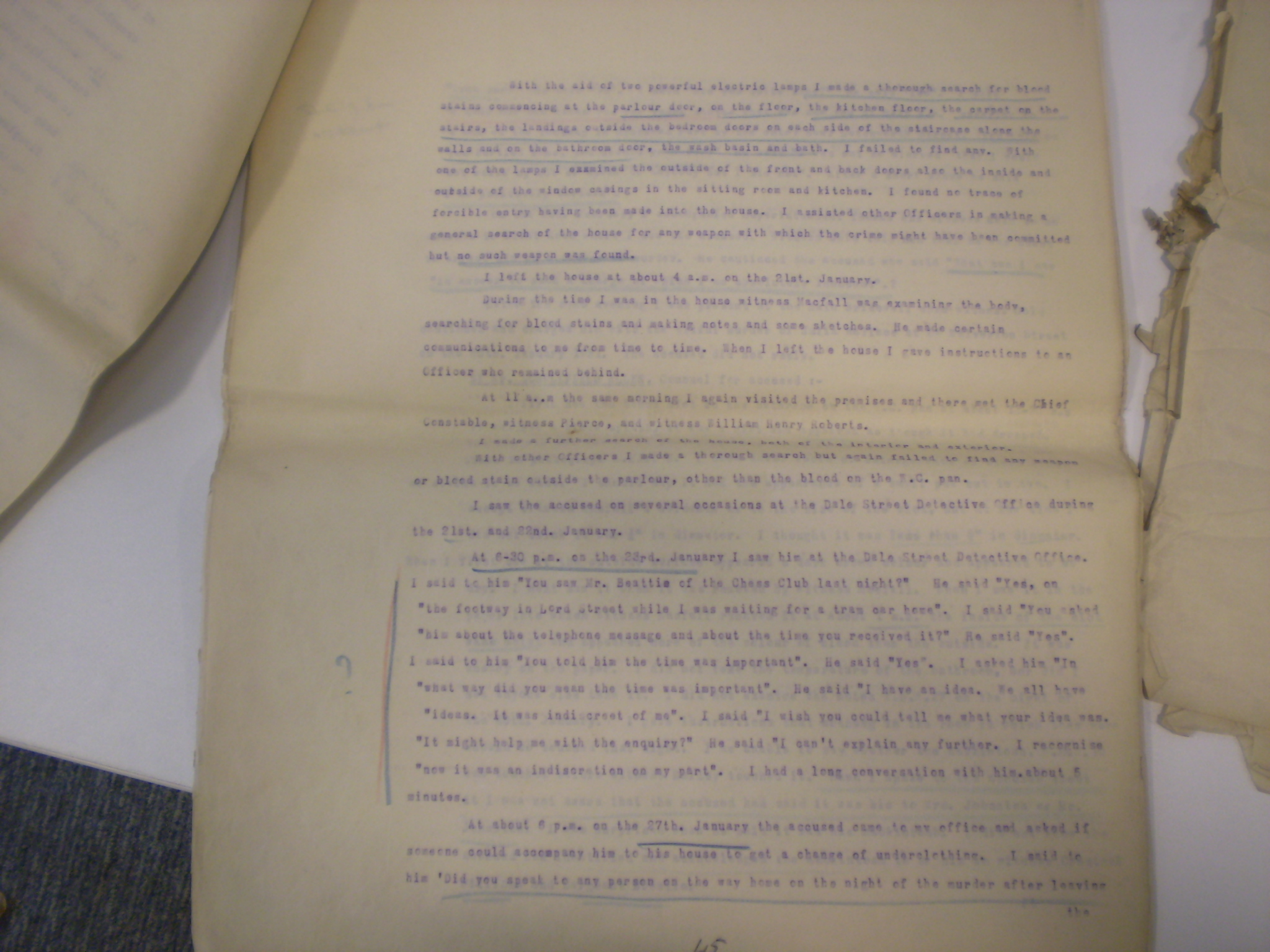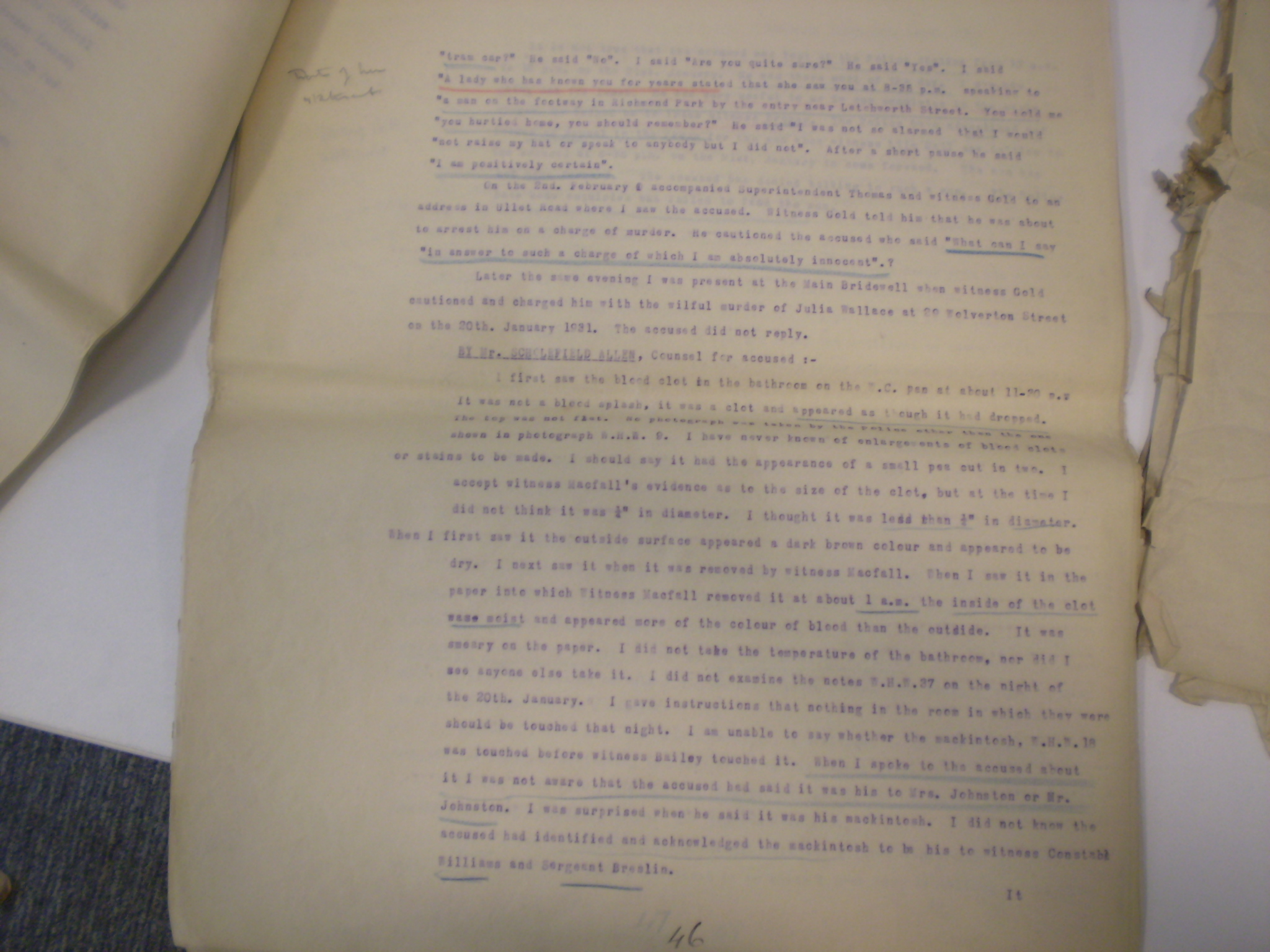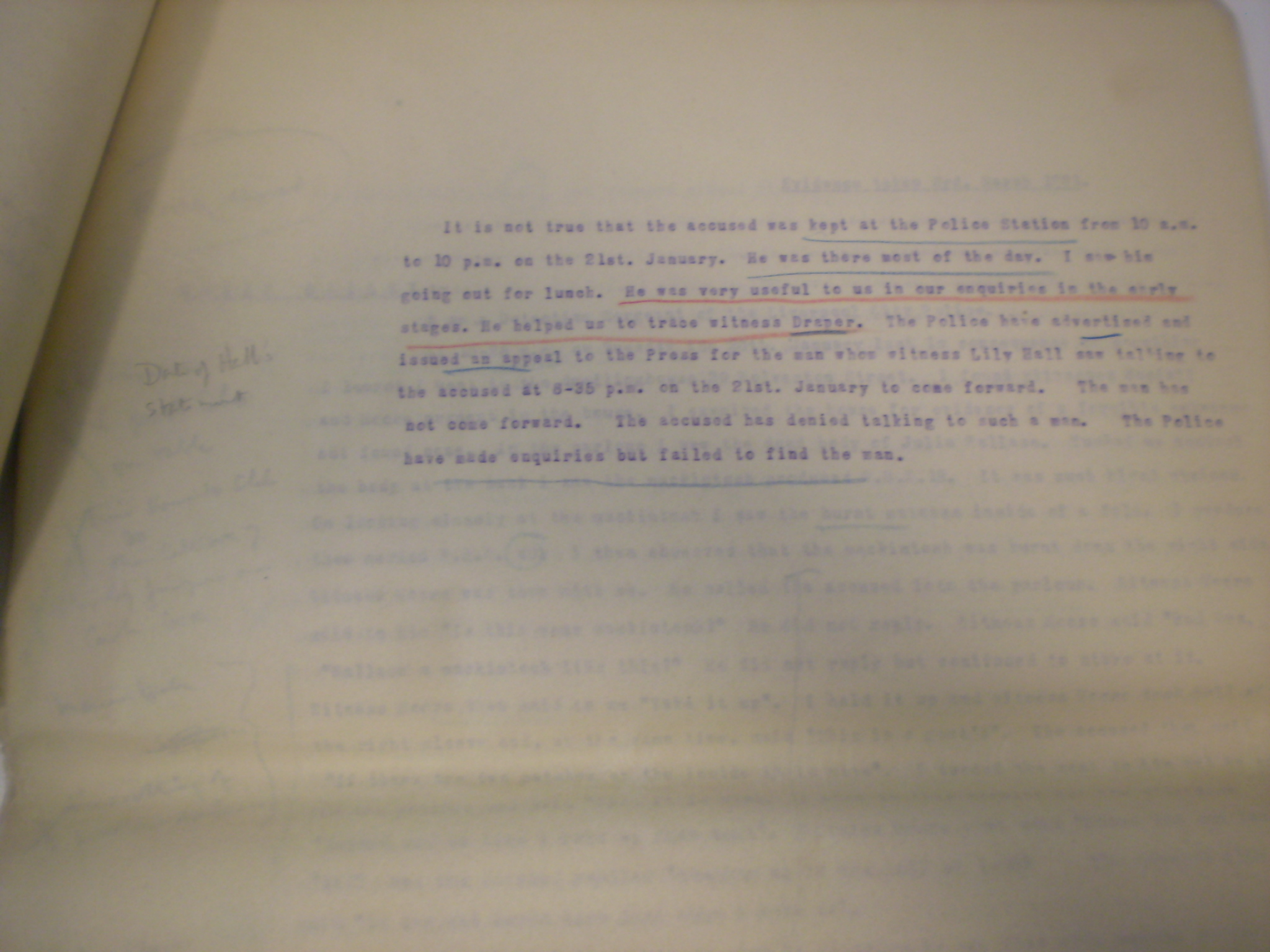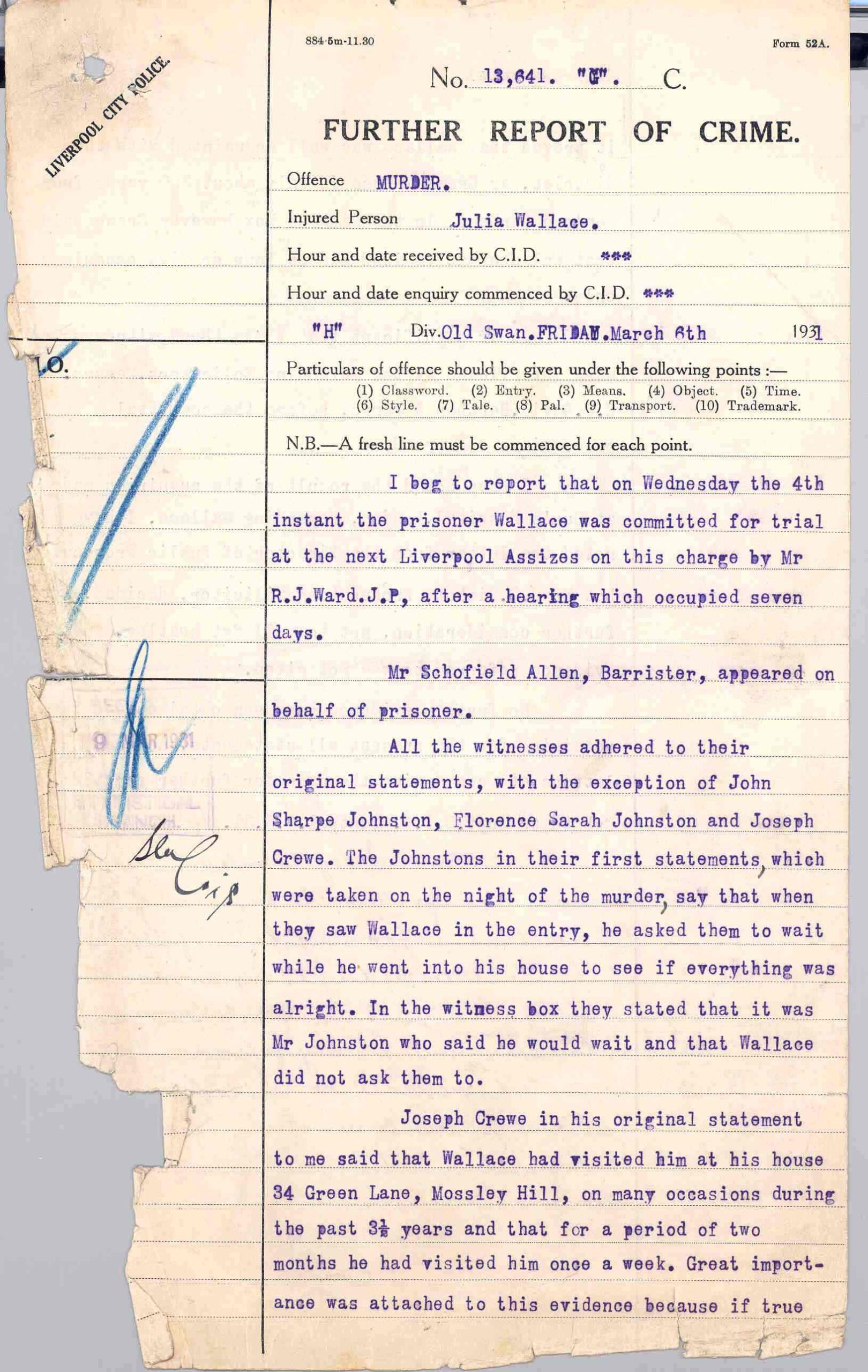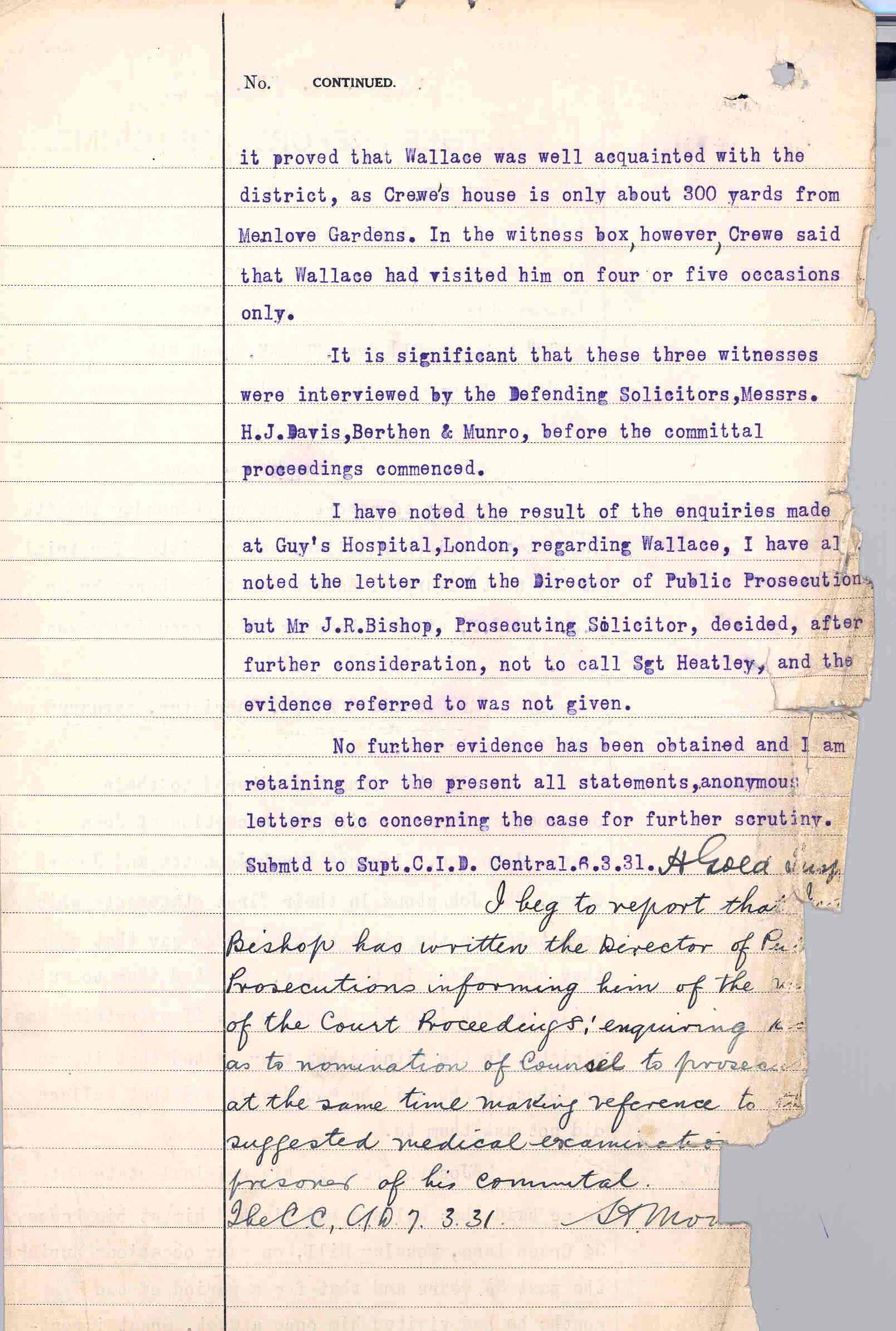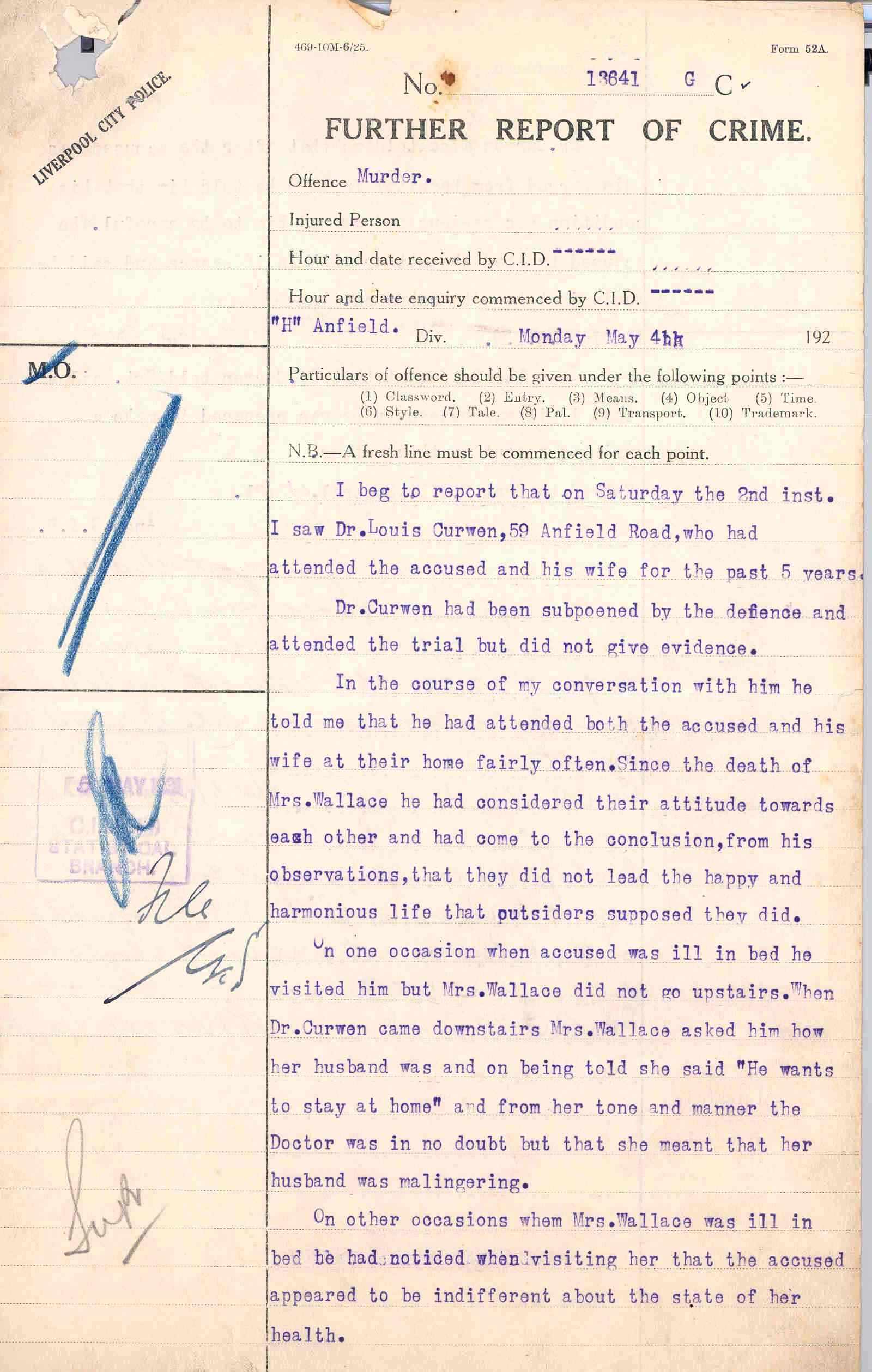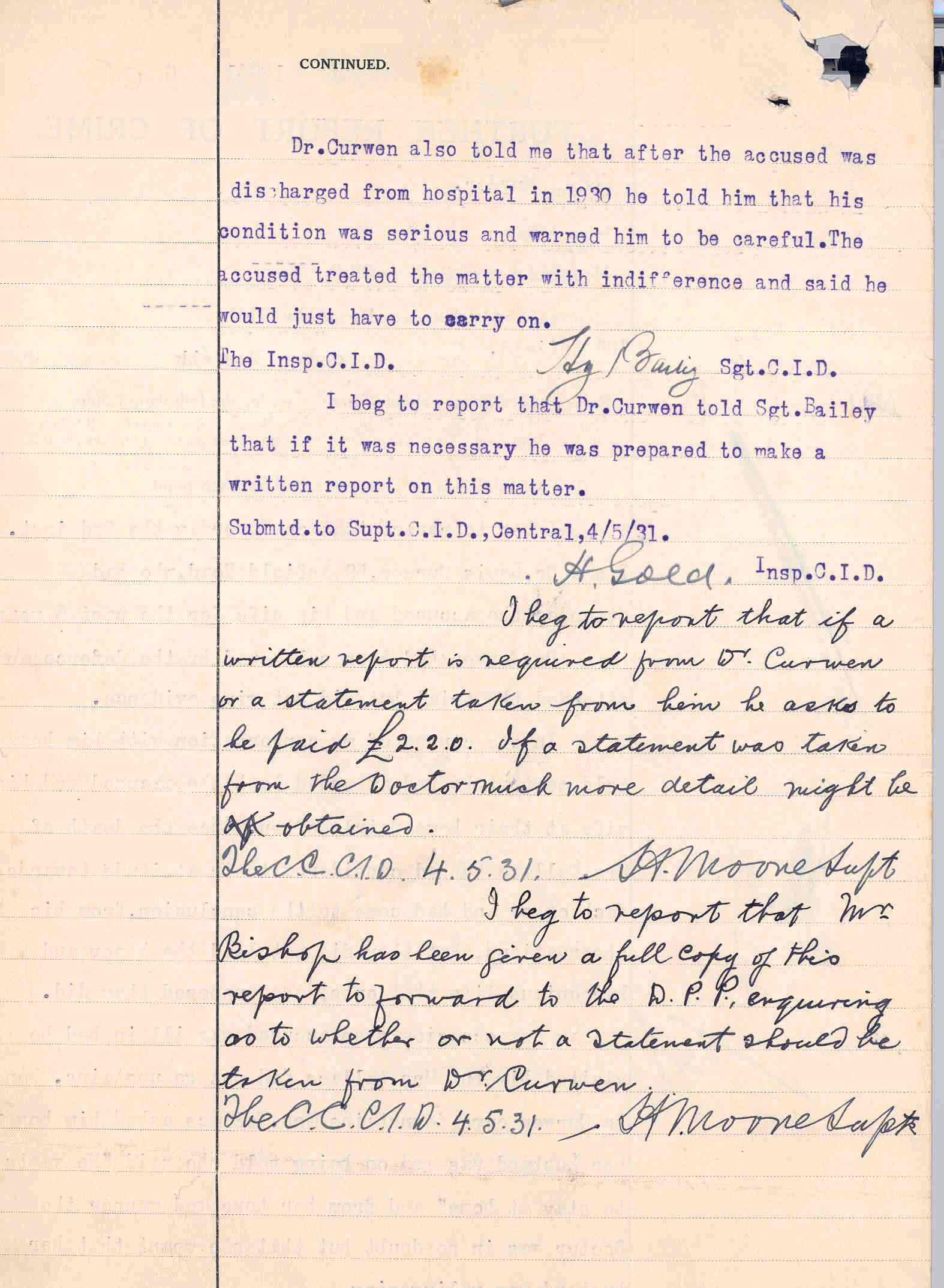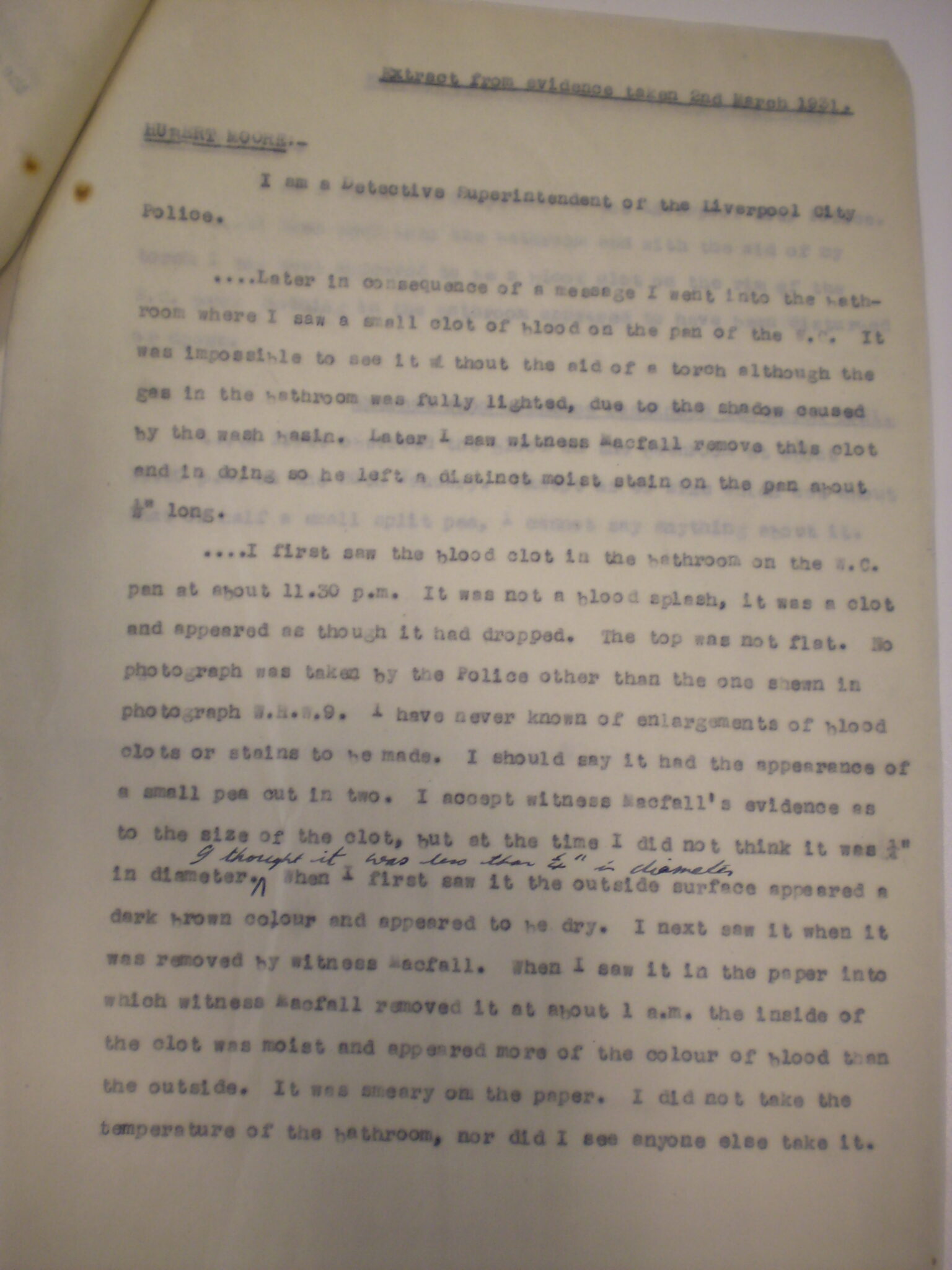25/01/1931:
C.I.D.Special Branch,
25th January 1931.
Hubert MOORE says:-
I am a Detective Superintendent in the Liverpool City Police.
At about 10p.m. on Tuesday the 20th.January 1931 in consequence of what I was told, I went with Detective Sergeant Fothergill to 29 Wolverton Street where I saw on the parlour floor the body of Julia Wallace. Her head was terribly battered in, and blood and portions of brain matter was on the floor.
Doctor McFall was on the scene of the outrage when I got there, and I agree with his description of the condition and position of the body as shewn in his statement.
I made a preliminary examination of the premises.
Nothing whatever was disturbed in the parlour. The hearthrug on which the body lay was as it would be ordinarily, not even one corner out of place. The skirt on the body was quite straight, and was not disarranged in any way.
I could find no trace whatever of the house being broken into, all the doors and windows being free from marks of forcible entry.
I asked Mr.Wallace (deceased’s husband) several questions as to how he found the house etc. In the course of his replies he said “When I tried the front door the key would not act”. “I tried the key in the door, but the lock was somewhat faulty. It was not like that to-day” (Expert says lock has been faulty for years). I tried the door with Mr.Wallace’s key and could open it although the lock was defective.
In the kitchen I saw the flap door of a small cabinet (which had previously been broken and repaired) was broken, and Wallace drew my attention to a small cash box on a bookcase some eight feet high [actually 7’2″] from which he said about £4.0.0. had been stolen by the supposed thief together with a postal order and cheque. A lady’s handbag was on a chair by the table in the kitchen. It was taken possession of by Sergeant Bailey. It contained £1-5-10½d, letters, and a King George halfcrown.
The back bedroom which was used as a workshop, and laboratory appeared not to have been disturbed. Nothing whatever appeared to have been disturbed in the middle bedroom which was the one used by deceased and her husband. Four £1-0-0 Treasury notes were in a small jar on the mantelpiece, and there was what appeared to be a bloodstain on one of these notes. The bed in the front bedroom was in disorder i.e. two pillows were on the floor and two lady’s handbags, together with three lady’s hats were on the mattress, the bedding being pushed from the side next the door towards the fireplace. The drawers in the dressing table, and the wardrobe had not been interfered with. There was a small clot of clood on the pan of the W.C. in the bathroom. This was examined, and taken away by Doctor McFall.
Close up against deceased’s body was a mackintosh in a crumpled and bloodstained condition. I called Wallace into the room, and said to him “Is this your mackintosh”. Wallace did not answer. I said “Had Mrs. Wallace a mackintosh like this”. Wallace remained silent. I said to Detective Sergeant Bailey “Take it up, and let us have a look at it” which he did. I got hold of the right sleeve, and on stretching it out said “This is a gents”. Wallace then got hold of it, and after a short examination said “If there’s two patches on the inside, it is mine. It’s mine, I wore it this morning, but the day turning out so fine I wore my fawn coat this afternoon. Of course it was not burned like that when I wore it”. I asked him where he had left it, and he said “Hanging up in the Hall at half past one.
The mackintosh was very much burned on the left side extending around to the centre of the skirt at the back.
A thorough search of 29 Wolverton Street was made on the night of the murder, and on subsequent days, but no trace was found of any instrument with which the crime might have been committed. No bloodstains were found other than on the parlour floor, one on the W.C.pan, and one on the £1-0-0 treasury note in the middle bedroom.
At 6.30p.m. on the 23rd January 1931 I saw Wallace at the Detective Office. I said to him “You saw Mr.Beattie of the Chess Club last night”. He said “Yes while I was waiting for a tramcar in Lord Street.” I said “You asked him about the telephone message, and what time he received it”. Wallace said “Yes”. I said “You told him the time was important”. Wallace said “Yes”. I asked him “In what way was it important”, and he replied “I had some ideas of my own. We all have ideas. It was indiscreet of me”. Wallace later said “I cannot say why I asked him. I admit it was an indiscretion on my park. I cannot say anything further”.
On the 27th January 1931 I again saw Wallace at the Detective Office where he had called enquiring after a change of clothing.
I enquired of him the route he had taken on his return from Menlove Gardens on the 20th January. He told me as shown in previous statements. I asked him if he had spoken to anyone on the way home, and he replied “Not as I remember”. I said “Are you quite sure” and he said “Yes”. I told him he had been seen speaking to a man in Richmond Park at about 8.35p.m. on that night. He said after some hesitation “I did not stand to speak to any person on my way from the tramcar to home. I decidedly did not. I wasn’t so alarmed that I would not speak to a person or raise my hat, but I did not. I am positively certain”.
28/01/1931:
LIVERPOOL CITY POLICE
DIV. “H”.
Station: C.I.D.Special Branch. 28/1/31.
From: The Superintendent.
To: The Chief Constable.
Subject{ MURDER – Juliar WALLACE, 29, Wolverton Street.
I bet to report that at 9.5p.m. on the 20th January 1931, Mr.John Sharp JOHNSTON, 31, Wolverton Street, Anfield, called at Anfield Road Bridewell and informed Constable 99″G” Saunders that Mrs.Wallace of 29, Wolverton Street, had been found murdered in her house a short time previously.
Con.Saunders, who was in charge of the Station, at once informed Con.191″G” Williams, who proceeded to Wolverton Street. At the same time Con. Saunders telephoned for the ambulance as a precautionary measure.
On arrival at 29, Wolverton Street, Con. Williams knocked at the door which was opened by William Herbert Wallace, the occupier of the house. Wallace at once said, “Come inside officer, something terrible has happened”.
On entering the house and going into the parlour the Constable found the body of Mrs.Julia Wallace lying on the hearthrug in front of the fireplace, with her head towards the door. Her head showed that it had been battered, the skull fractured, portions of brain matter and large quantities of blood on the floor. The Constable got hold of the woman’s hand and althought it was slightly warm it was quite apparent she was dead.
In the meantime Con.Saunders endeavoured to get in touch with the Divisional C.I.D., and failing to do so he telephoned the C.I.D.Central, at 9.40p.m. I was informed at my house by telephone immediately afterwards. Following this I telephoned to Constable Harrison, at C.I.D.Central, instructing him to send a multiple call to all C.I.D. Inspectors in the City, informing them of the contents of the message from Con.99″G” Saunders, and asking them and their staffs to stand by for instructions.
At 10.0p.m. Sergeant Fothergill and I arrived at 29, Wolverton Street, where I found the body of Mrs. Wallace on the parlour floor. She was lying diagonally across the hearthrug with feet together and touching the end of the fender nearest the window. Her head was clear of the rug and on the carpet.
The body was dressed in what appeared to be her ordinary indoor clothing which was not disarranged in any way whatever. The face was slightly turned towards the left.
The head shewed that it had been viciously battered with some heavy instrument, there being much blood and portions of brain matter on the floor. The walls of the parlour and articles of the furniture were bespattered with blood, some of the splashes being seven or eight feet high. There was a gent’s macintosh in a crumpled condition tucked up against the deceased’s head and shoulders. This shewed many splashes and blotches of blood, on the front and on, and inside the sleeve cuffs. A portion of the bottom of the macintosh on the left side was burned.
When I arrived at the house Dr.McFall, 15, Green Lane, was present, he having been informed by telephone, and he was making an examination of the body and the room.
After making a preliminary examination of the premises I went to Anfield Road Bridewell, and telephoned particulars of the murder to Inspector Wallace, C.I.D. Special Branch, instructing him to telephone at once to all Divisions, for immediate enquiry at Lodging Houses, Railway Stations, Night Cafes, and other likely places, at the same time intimating that the assailant would have considerable bloodstains on his clothing. I also telephoned Mr. Glover, the Assistant Chief Constable, who shortly afterwards arrived, and after consultation with Dr.McFall, telephoned Dr.Pierce, Police Surgeon, who hastened to the scene.
On my return to 29, Wolverton Street, I found that Inspectors Gold and Langford had arrived and a thorough search and examination of the premises was commenced with a view to discovering any instrument with which the crime had been committed, fingerprints, or anything of that nature that might assist in establishing the identity of the murderer. Apart from what was found in the parlour, the only thing that was found was a small clot of blood on the edge of the basin of the W.C. in the bathroom, which indicated that the murderer, after committing the crime, washed himself or his hands in the bathroom.
The clot of blood was carefully examined by Doctors McFall and Pierce, Dr.McFall taking possession of it.
Photographs of the body and parlour were taken, as was also a photograph of the bathroom, shewing the clot of blood on the W.C.pan. The Coroner’s Beadle, Inspr. Glasson, who had been informed of the murder by telephone, had the body removed to the Princes Dock Mortuary.
The report of Dr.McFall, which is attached, gives a detailed account of the condition of the body, and the parlour, blood splashes etc.
Whilst the search and examination of the premises were in progress, Mrs.Wallace, 85, Ullet Road, sister-in-law to William Herbert Wallace, accompanied by her son, called, and together they remained in conversation with the occupier, Mr. Wallace, the latter not being in the least disturbed, but quietly answering all questions put to him.
When the examinsation was first started I called Mr.Wallace into the parlour and asked him if he knew anything of the macintosh found by deceased’s head. He looked for some second at the garment but did not say anything. I asked if Mrs.Wallace had a macintosh like that but he still remained silent. Sergt.Bailey then lifted up the macintosh and on my straightening out the right arm I said, “This is a gent’s”. Wallace then examined it and said, “If there’s a patch on the inside it’s mine. It’s mine. I wore it this morning, but the day turned out so fine I wore my fawn coat this evening. Of course it was not burned like that when I wore it”.
Mr.Wallace, husband os the deceased woman, was questioned as to his movements. Briefly he stated that when at the Chess Club, City Cafe, 24, North John Street, the previous evening, he had received a message, telephoned to him at the cafe and received by another member of the Club, to go to 25, Menlove Gardens East, at 7.30p.m. that night to see a Mr.Qualtrough. He did not know a Mr. Qualtrough but he had left the house at 6.45p.m. and gone to Menlove Gardens East, his wife being then alive and in the house. He left by the back door and heard his wife bolt it behind him [did not state this?]. He was unable to find the address Menlove Gardens East, and returned to the house at 8.40p.m. He tried to open the front door with the key, but it would not open. He then went round to the back, went up the yard, the yard door being unbolted, and tried to open the back kitchen door. This would not open so he again went to the front door and after trying that well he discovered the key would not act. He again rushed round to the back and saw his neighbours Mr. and Mrs. Johnston, 31, Wolverton Street, leaving by their back door. He asked them if they had heard any suspicious noises and asked them to wait awhile while he again tried to get in, because he feared somethign had happened. He then went to the back kitchen door again and found it opened easily. He walked in the back kitchen and lighted the gas in the kitchen, then went upstairs and found everything correct. He returned downstairs and went into the parlour, struck a match, and found his wife lying on the floor as she then was. He felt her hand and found she was dead and then he went to the back and told Mr. and Mrs. Johnston.
Mrs.Wallace, sister-in-law, 83, Ullet Road, ____ she had been at the house between 4.0p.m. and 4.30p.m. that day visiting the deceased woman who was then all right. A statement was also taken from Mr. and Mrs.Johnston, 31, Wolverton Street, who stated that Mr.Wallace had asked them to stand by while he went into the house, and that he came out shortly afterwards and asked them to go in which they did.
Before examination of the premises was completed, Wallace was taken to Anfield Road Bridewell, where a statement was taken from him concerning his movements. His clothing and boots were thoroughly searched for bloodstains, and although none were found all the circumstances pointed to his being the murderer, but it was not considered that the evidence available would justify his being detained. Afterwards he was taken to his sister-in-law’s house, 83, Ullet Road, where he stayed for the remainder of the night.
However, as a precaution, throughout the night all members of the C.I.D. made diligent enquiry of all lodging houses for any suspicious characters, the probability of blood stained clothing being the main indication of the murderer, and known thieves of violent tendencies were looked up and questioned, but no useful information was obtained.
At 10.0a.m. Wednesday, 21st January, Mr. Wallace attended this office by request, and remained here until late that night. Throughout the day C.I.D. Officers made enquiry from house to house in the street, the surrounding neighbourhood was searched for any weapon or blood-stained clothing, the house was again thoroughly examined, the Chief Constable and Professor W.H.Roberts, City Analyst, visiting it. The receipients of the telephone message at the Chess Club on the night of the 19th instant, were traced; Mr. Wallace’s movements on the evening of the crime, as given in his statement, were traced and verified as shewn in the statements; and considerable publicity was given to the “Crime” in the Press.
On the 21st instant, Professor McFall and Dr.Pierce, Police Surgeon, conducted a Post Mortem examination of the body from which it was learned that the murderer had inflicted several blows on the front and back of the head, of an exceptionally violent nature.
On Thursday, 22nd instant, an inquest was held which, after evidence of identification had been given was adjourned until the 5th February. The same day, as a result of enquiries through the Intelligence Department of the Post Office, it was ascertained that the telephone message to the City Cafe for Mr.Wallace, on the evening of the 19th instant, had been sent from a Public Telephone Call Box at the corner of Lower Breck Road and Breck Road, a matter of 300 yards from 29, Wolverton Street, at 7.20p.m. on 19th instant. A record of this message was made at the telephone exchange as, when the caller was first “plugged” through, he got no answer, necessitating him making a second call, complaining of not being put through properly first. After some conversation he was returned the 2d he paid for the second call, and his number obtained for him. The operator then made out a slip shewing the telephone numbers and the time of the call, and nature of the complaint. From enquiries of members of the Chess Club it was also definitely established that Mr.Wallace did not arrive at the City Cafe earlier than 7.45p.m. on that day.
The two telephone operators, Miss. Alfreds and Miss Kelly, speak of the man who asked for the call as having an ordinary voice, rather polite, whereas Mr. Beattie who received the message at the Cafe speaks of the voice as being gruss, and apparently disguised [he never said disguised]. Mr. Beattie would know Wallace’s ordinary voice.
After examining the house on Thursday, 22nd instant, in company with Sergt.Bailey, Mr.Wallace stated that all his wife’s jewellery etc., appeared intact, and nothign was found to be missing from the cashbox beyond the £4; a Postal Order No.65/5.491246, for 4/6d; and a cheque No.19318, dated 16.1.31 for £5.17/- made payable to W.H.Wallace by his employers, The Prudential Assurance Co., drawn on the Midland Bank, 62, Castle Street. Particulars of the Postal Order were left with the Post Office Intelligent Department, who wrote the M.O. Department on our behalf for notification as soon as it was cashed, and payment of the cheque was stopped. The cheque is not endorsed, and should it be presented we will be immediately informed.
Numerous articles, such asW.C.pan, locs, carpets, pictures, towels etc., as detailed on the attached list, which were bloodstained or likely to have traces of bloodstains on them, were removed to the Property Office, and the majority of them were later handed to the City Analyst.
On the 23rd instant, it was established that a small poker was missing from the kitchen fireplace, and a piece of iron bar was missing from the parlour fireplace of 29, Wolverton Street. This information was circulated by multiple call to all C.I.Ds.
Detailed plans of the house and the rooms therein have been prepared by the Surveyors Department, Liverpool Corporation, and the Cleansing Department has conducted a search of street grids of the neighbourhood, and the drains of 29, Wolverton Street.
Since the murder was committed numerous items of information have been obtained from the Public, and ___ but except in those instanced where statements are attached to the file, they have been proved to have no connection with this crime.
As a result of the investigation the present position is that the husband of the murdered woman is strongly suspected. The facts, summarised, are that the deceased woman was last seen alive at 6.35p.m. Tuesday, 20th instant, by Allan Croston (sic) Close, who delivered milk to her at 29, Wolverton Street, at that time. At 8.40p.m. she was discovered by her husband, lying in the parlour murdered. There were no sighs of any struggle. A flimsily built wooden cabinet in the kitchen, the door of which had previously been broken and repaired with a thin strip of wood, had the door pulled off and a half-crown and two separate shillings were on the floor of the kitchen immediately below. From an unlocked cash box on a shelf above the cabinet it is alleged by accused that about £4, made up of one £1 note, three 10/- notes, and between 30/- and 40/- in silver, and Postal Order No. 65/5.491246 for 4/6d, were missing. There is no sign of any other article of furniture in the house being disturbed. There is no trace of any forcible entry into the house on the part of the supposed thief, and except for the single clot of blood found on the W.C. pan in the bathroom, not a bloodstained mark of any kind could be found in the house, apart from the parlour in whcih the murder was comitted
Protruding from a vase on the mantelpiece in the middle bedroom, where the murdered woman and her husband slept, was found four £1 notes, and a Postal Order for 2/- No.0/29.451809 issued on 3.1.31.
Wallace is suspected of having himself sent the telephone message to the Chess Club, giving the message that a Mr.R.M.Qualtrough, 25, Menlove Gardens East (no such address exists) wanted to see Mr.Wallace at 7.30p.m. Tuesday, 20th instant, as he had some business for him, because Mr.Wallace is not a regular attender at the meetings, and before becoming notorious through this case, he was not a well known member. Menlove Gardens locally is not the district in which Mr.Wallace collects as an agent for the Prudential Insurance Co, the telephone message was sent from the Call box nearest his home address; and the time between 7.20p.m. when the message was sent, and 7.45p.m. when he arrived at the Chess Club, allows him ample time to travel by tramcar from the Call Box to North John Street, where the City Cafe is situated. On the evening of the murder, Mr.Wallace, on his own statement was the last person to see his wife alive at 6.45p.m. He also was the first person to find her murdered at 8.40p.m. Between these two times he has, as a result of minute questioning reduced to statement form, accounted for his movements. He appears to have been over-anxious to establish an alibi because of the amount of enquiry he made of different people to find Qualtrough, 25, Menlove Gardens East, is exception. Also one of the notes found in the vase on the mantelpiece in the middle bedroom bears a slight bloodstain which leads to the suspicion that Wallace, having taken the notes from the cashbox to support his allegation of a robbery, later placed them in the vase after committing the murder. A thief would not do this. This bloodstain has been examined by Professor Roberts, City Analyst, whos tates it is human blood of a similar “period” as the blood found in the parlour.
It is significant that the value of the money alleged to be stolen (£4 and a postal order) is the same as that found in the bedroom (£4 and a postal order).
So far his statements as regards his movements have been verified and despite all questioning he has not varied them. The motive is obscure, but a solution is probably found in his affliction – he has only one kidney and that is failing – which is often associated with various forms of insanity. He has been married for the past sixteen years and there have been no children to the marriage. He isan unusual man and his composure is amazing. He is well educated and very interested in Chemistry, which subject he taught for four years at the Technical School.
Up to the present all efforts to trace the weapon with which the crime was committed, have failed, and so far nothing has been found to definitely bring home the crime to him. The exmaination fo the various objects brought from the house has not yet been completed by the City Analyst.
On Sunday, 25th january, information was obtained from a Miss Lily Hall, 9, Letchworth Street, a typist, that on Tuesday, 20th instant, shortly after 8.35p.m. she saw Wallace in Richmond Park standing by the passage leading to Sedley Street, talking to a man. Wallace when seen by me later denied having spoken to anyone in Richmond Park at the time, and efforts are being made, with the help of “Press” publicity, to find this man.
Attached are photographs taken in the house by Con.Cooke, C.I.D.Headquarters showing the body as found in the parlour, the kitchen and the place where the cabinet door was broken, the bathroom where the clot of blood was found on the W.C.pan, and the front and rear of the house; also detailed plans of the house, and the various statements taken in connection with the investigation.
Enquiries are being continued.
H.Moore Supt, C.I.C.
02/03/1931:
Evidence taken 2nd. March 1931.
HUBERT MOORE:–
I am a Detective Superintendent of the Liverpool City Police.
At about 10-0 p.m. on the 20th.January last in consequence of a message, I called at 29 Wolverton Street. The door was opened by witness Constable Williams.
I looked in the sitting room and saw witness Macfall seated on the arm of an easy chair making notes. I saw the body of the deceased lying on the hearthrug. I saw the accused and witnesses Mr. and Mrs. Johnston in the kitchen. Witness Constable Williams made a statement to me after which I made a hurried examination of the house. I asked the accused if he had seen anyone about when he returned home and asked witness Florence Sarah Johnston in the accused’s presence, if she had heard any unusual noises in the house. She said she had not [two “thumps?”], and the accused said he had not seen anyone.
I gave Constable Williams certain instructions as I left the house returning in about half hour. I then comenced a thorough examination of the house. I found the lock of the front door had no marks on it. The furniture in the sitting room was apparently undisturbed,/span>, the chairs, tables, and __ apeared to be in the same position as one could expect, as was also the hearthrug. On going into the kitchen I saw the accused. I asked him how he had found the house on his return. He said he was called by telephone on a businessappointment at 27 (?) Menlove Gardens East at 7-30 tonight. I went there but could not find the address. I hurried home. I tried the key in the front door but the key would not act. I went around to the back door but I could not open it. I returned to the front door, again tried the key which would not act, went around to the back door which opened easily. I met Mr. & Mrs. Johnston and asked them to wait while I came in. I found my wife murdered in the parlour and this just as you see it (pointing to the small cabinet produced W.H.W.19 (?), the door of which was broken off, a portion of it lying on the floor). He then pointed to the cash box W.H.W.20 and said “about four pounds has been stolen from that box, which included a £1 Treasurey Note, three 10/- Treasury Notes, about 20 or 40 shillings in silver, a cheque, and a Postal Order. That was my Company’s money”.
On the floor close to the back shelves and cupboard to the left of the fireplace I saw half crown place and two separate shilling pieces. There are produced in envelope W.H.W.__ I asked accused, I asked accused where he had found the cash box and he said “Where it is now”. It was on the top of the bookcase as above in the photograph W.H.W._. I reached down the cash box, put it on the table, took off the lid of which the hinge was broken, took out the money container and in one of the compartments I found an American dollar bill W.H.W.__. The other two compartments were empty. I said to the accused “I cannot understand why a thief should go to all this trouble fixing the lid on and putting the boc back on the shelf where he had found it”.
I asked the accused to accompany as upstairs which he did. Directly opposite the stairs there is a small room which the accused said was his workshop. There were a number of tools in the room, including __ ____. There was some photographic materials and a case containing a number of bottles. I asked the accused to have a good look in the room to see if any article was missing. He looked around and examined a few boxes and said I cannot say that anything is missing”.
I then went in with him to the middle bedroom. This has been described by other witnesses as the back bedroom. Nothing appeared to have been disturbed. In that room there was a small jar on the mantel piece. it is the one produced W.H.W.19. I could see there were some Treasure Notes in it.
I next went into the front bedroom with the accused. There I found the bed in disorder, two pillows were on the floor between the fireplace and the window, the clothingand the bed __ had been pushed __ the fireplace from the __, exposing a portion of the mattress. On the mattress there were two lady’s hand bags and one lady’s hat. There were also two lady’s hats on the disturbed bed clothing quite close to the other hat. I asked the accused if the room had been used recently or if he could say if the bedding was like that that day. He replied “I cannot say. I don’t think I have been in this room for a fortnight”. I noticed the clothing in the wardrobe and in the drawers of the dressing table had not been disturbed.
We then returned downstairs and made a further examination of the parlour. Later in consequence of a message I went into the bathroom where I saw a small clot of blood on the pan of the W.C.. It was impossible to see it without the aid of a torch although the gas in the bathroom was fully lighted, due to the shadow caused by the wash basin. Later I saw witness Macfall remove this clot and in doing so he left a distinct __ stain on the pan about half inch long.
I went downstairs, by which time other officers had arrived. I examined the lock W.H.W.__ very carefully. Witness Gold was with me. I called the accused out and asked him for his door key which he gave me. I tried the key in the lock and found that the lock would turn to a certain point but if the key were turned too far around, the lock would slip and the door would again be locked. I went out on to the door step, pulling the door towards me as locking it. I tried the key in the loc and with a little __ I opened the door and re-entered the house. I said to the accused who was just __ the door “I could open the door all right, but the lock is defective”. The accused said “It was not like that this morning”.
I retained the key and went into the sitting room. I made a further __ of the body, the clothing on which was not disturbed. The mackintosh W.H.W.__ was in a crimpled condition about half its ordinary length, tucked up against and slightly underneath the right shoulder and head. No part of the body was __ actually on it (?). Between the body and the sideboard as above in the photograph W.H.W.7, there was a considerable amount of blood. On the right hand side of the room between the piano and the boxy there was a considerable quantity of brain matter and anyone requiring to reach the fireplace on that side of the body would have to do so very carefully to avoid stepping on to the brain matter. I asked the accused if the blinds were drawn when he entered the room. He said “Yes. I lit a match and put the gas on”. I said “Did you scream of shout?” He said “No I thought she might have been in a fit. I lit the gas to go to her assistance but of course I found that she was dead”.
A little later I again called the accused into the sitting room and pointing to the mackintosh I said to him “Is this your mackintosh?” He put his left hand to hisface, stooped slightly and looked towards the body. He made no reply to my question. In about 30 seconds I said “Had Mrs. Wallace a mackintosh like that?” The accused made no reply. He was at that time on my left slightly behind me in the sitting room doorway. Witness Bailey was standing in front of both of us. I said to witness Bailey “Take it up and let us have a look at it”. Witness Bailey lifted up and held it with the inside towards him. I took hold of the right sleeve and stretched it out. I said “This is a gent’s”. By that time the accused had got hold of the mackintosh saying “If there are two pathced on the inside, it is mine”. The accused found two patches and said “It is mine. I wore it this morning. The day turning out so fine I wore my fawn coat this afternoon. Of course it was not burnt like that when I wore it”. I asked him where he had left the mackintosh. He said “Hanging in the hall at half past one”. There was a rack in the hall opposite the parlour door.
A little later I asked the accused to accompany a Police Officer to Anfield Road Police Station telling him there were better facilities there for taking a detailed statement from him. He left the house in company with witness Gold.
By this time the accused’s sister-in-law and her son had arrived. In consequence of what I said to them they left so also did certain Police Officers.
With the aid of two powerful electric lamps I made a thorough search for blood stains commencing at the parlour door, on the floor, the kitchen floor, the carpet on the stairs, the landing outside the bedroom doors on each side of the staircase along the walls and on the bathroom door, the wash basin and bath. I failed to find any. With one of the lamps I examined the outside of the front and back doors also the inside and outside of the window casings in the sitting room and kitchen. I found no trace of forcible entry having been made into the house. I assisted other Officers in making a general search of the house for any weapon with which the crime might have been committed but no such weapon was found.
I left the house at about 4 a.m. on the 21st. January.
During the time I was in the house witness Macfall was examining the body, searching for blood stains and making notes and some sketches. He made certain communications to me from time to time. When I left the house I gave instructions to an Officer who remained behind.
At 11 a.m. the same morning I again visited the premises and there met the Chief Constable, witness Pierce, and witness William Henry Roberts.
I made a further search of the house, both of the interior and exterior.
With other Officers I made a thorough search but again failed to find any weapon or blood stain outside the parlour, other than the blood on the W.C. pan.
I saw the accused on several occasions at the Dale Street Detective Office during the 21st and 22nd January.
At _-30 p.m. on the 23rd. January I saw him at the Dale Street Detective Office. I said to him “You saw Mr. Beattie of the Chess Club last night?” He said “Yes, on the footway in Lord Street while I was waiting for a tram car home”. I said “You asked him about the telephone message and about the time you received it?” He said “Yes”. I said to him “You told him the time was important”. He said “Yes”. I asked him “In what way did you mean the time was important”. He said “I have an idea. We all have ideas. It was indiscreet of me”. I said “I wish you could tell me what your idea was. It might help me with the enquiry?” He said “I can’t explain any further. I recognise now it was an indiscretion on my part”. I had a long conversation with him.about 5 minutes.
At about 6 p.m. on the 27th January the accused came to my office and asked if someone could accompany him to his house to get a change of underclothing. I said to him “Did you speak to any person on the way home on the night of the murder after leaving the tram car?” He said “No”. I said “Are you quite sure?” he said “Yes”. I said “A lady who has known you for years stated that she saw you at 8-__ p.m. speaking to a man on the footway in Richmond Park by the entry near Letchworth Street. You told me you hurried home, you should remember?” He said “I was not so alarmed that I would not raise my hat or speak to anybody but I did not”. After a short pause he said “I am positively certain”.
On the 2nd. February I accompanied Superintendent Thomas and witness Gold to an address in Ullet Road where I saw the accused. Witness Gold told him that he was about to arrest him on a charge of murder. He cautioned the accused who said “What can I say in answer to such a charge of which I am absolutely innocent?”.
Later the same evening I was present at the Main Bridewell when witness Gold cautioned and charged him with the wilful murder of Julia Wallace at 29 Wolverton Street on the 20th. January 1931. The accused did not reply.
BY Mt. SCHOLEFIELD ALLEN, Counsel for accused :-
I first saw the blood clot in the bathroom on the W.C. pan at about 11-3(?)0 p.m.
It was not a blood splash, it was a clot and appeared as though it had dropped. The top was not flat. No photograph was taken by the Police other than the one shown in photograph W.h.W.9. I have never known of enlargements of blood clots or stains to be made. I should say it had the appearance of a small pea cut in two. I accept witness Macfall’s evidence as to the size of the clot, but at the time I did not think it was half inch in diameter. I thought it was less than half inch in diameter.
When I first saw it the outside surface appeared a dark brown colour and appeared to be dry. I next saw it when it was removed by witness Macfall. Then I saw it in the paper into which Witness Macfall removed it at about 1 a.m. the inside of the clot was moist and appeared more of the colour of blood than the outside. It was smeary on the paper. i did not take the temperature of the bathroom, nor did I see anyone else take it. I did not examine the notes W.H.W.27 on the night of the 20th. January. I gave instructions that nothing in the room in which they were should be touched that night. I am unable to say whether the mackintosh, W.H.W.1_ was touched before witness Bailey touched it. When I spoke to the accused about it I was not aware that the accused had said it was his to Mrs. Johnston or Mr. Johnston. I was surprised when he said it was his mackintosh. I did not know the accused had identified and acknowledged the mackintosh to be his to witness Constable Williams and Sergeant Breslin.
It is not true that the accused was kept at the police station from 10 a.m. to 10 p.m. on the 21st. January. He was there most of the day. I saw him going out for lunch. He was very useful to us in our enquiries in the early stages. He helped us to trace witness Draper. The Police have advertised and issued an appeal in the Press for the man whom witness Lily Hall saw talking to the accused at 8-35 p.m. on the 21st. January to come forward. The man has not come forward. The accused has denied talking to such a man. The Police have made enquiries but failed to find the man.
06/03/1931 (Partially Destroyed):
884 5m-11.30 | Form 52A.
No. 13,641. “G”. C.
FURTHER REPORT OF CRIME.
Offence MURDER
Injured Person Julia Wallace
Hour and date received by C.I.D. ***
Hour and date enquiry commenced by C.I.D. ***
“H” Div.Old Swan.FRIDAY.March 6th 1931
Particulars of offence should be given under the following points:-
(1) Classword. (2) Entry. (3) Means. (4) Object. (5) Time.
(6) Style. (7) Tale. (8) Pal. (9) Transport. (10) Trademark.
N.B.-A fresh line must be commenced for each point.
I beg to report that on Wednesday the 4th instant the prisoner Wallace was committed for trial at the next Liverpool Assizes on this charge by Mr R.J.Ward.J.O, after a hearing which occupied seven days.
Mr. Shofield Allen, Barriester, appeared on behalf of prisoner.
All the witnesses adhered to their original statements, with the exception of John Sharpe Johnston, Florence Sarah Johnston and Joseph Crewe. The Johnstons in their first statements which were taken on the night of the muder, say that when they saw Wallace in the entry, he asked them to wait while he went into his house to see if everything was alright. In the witness box they stated that it was Mr. Johnston who said he would wait and that Wallace did not ask them to.
Joseph Crewe in his original statement to me said that Wallace had visited him at his house 24 Green Lane, Mossley Hill, on many occasions during the past 3 and a half years and that for a period of two months he had visited him once a week. Great importance was attached to this evidence because if true it proved that Wallace was well acquainted with the district, as Crewe’s house is only about 300 yards from Menlove Gardens. In the witness box, however, Crewe said that Wallace had visited him on four or five occasions only.
It is significant that these three witnesses were interviewed by the Defending Solicitors,Messrs. H.J.Davis,Berthen & Munro, before the committal proceedings commenced.
I have noted the result of the enquiries made at Guy’s Hospital, London, regarding Wallace, I have al[missing] noted the letter from the Director of Public Prosecution[missing] but Mr J.R.Bishop, Prosecution Solicitor, decided, after further consideration, not to call Sgt Heatley, and the evidence referred to was not given.
No further evidence has been obtained and I am retaining for the present all statements, anonymous letters etc concerning the case for further scrutiny. Submtd to Supt.C.I.D. Central.6.3.31.
(___ I beg to report that [missing] Bishop has written the Director of Public Prosecutions informing him of the [missing] of the Court Proceedings:enquiring [missing] as to nomination of Counsel to __ at the same time making reference to [missing] suggested medical examination [missing] prisoner of his commital.
___ 7.3.31 HMoore
04/05/1931:
469-10M-6/25. | Form 52A.
No. 13641 G C
FURTHER REPORT OF CRIME.
Offence MURDER
Injured Person ……
Hour and date received by C.I.D. ……
Hour and date enquiry commenced by C.I.D. ……
“H” Anfield Div. Monday May 4th
Particulars of offence should be given under the following points:-
(1) Classword. (2) Entry. (3) Means. (4) Object. (5) Time.
(6) Style. (7) Tale. (8) Pal. (9) Transport. (10) Trademark.
N.B.-A fresh line must be commenced for each point.
I beg to report that on Saturday the 2nd inst. I saw Dr.Louis Curwen,59 Anfield Road, who had attended the accused and his wife for the past 5 years.
Dr.Curwen had been subpoened by the defence and attended the trial but did not give evidence.
In the course of my conversation with him he told me that he had attended both the accused and his wife at their home fairly often.Since the death of Mrs.Wallace he had considered their attitude towards each other and had come to the conclusion, from his observations,that they did not lead the happy and harmonious life that outsiders supposed they did.
On one occasion when accused was ill in bed he visited him but Mrs.Wallace did not go upstairs.When Dr.Curwen came downstairs Mrs.Wallace asked him how her husband was and on being told she said “He wants to stay at home” and from her tone and manner the Doctor was in no doubt but that she meant that her husband was malingering.
On other occasions when Mrs.Wallace was ill in bed he had noticed when visiting her that the accused appeared to be indifferent about the state of her health.
Dr.Curwen also told me that after the accused was discharged from hospital in 1930 he told him that his condition was serious and warned him to be careful.The accused treated the matter with indifference and said he would just have to carry on.
The Insp.C.I.D. Hy Baily Sgt.C.I.D.
I beg to report that Dr.Curwen told Sgt.Bailey that if it was necessary he was prepared to make a written report on the matter.
Submtd.to Supt.C.I.D.,Central,4/5/31.
HGold. Insp.C.I.D.
I beg to report that if a written report is required from Dr. Curwen or a statement taken from him he asks to be paid £2.2.0. If a statement was taken from the doctor much more detail might be obtained.
__C.I.D. 4.5.31. HMoore Supt
I beg to report that Mr Bishop has been given a full copy of this report to forward to the D.O.O. enquiring as to whether or not a statement should be taken from Dr.Curwen
___C.I.D. 4.5.31 – HMoore Supt
Munro Files:
Extract from evidence taken 2nd March 1931.
HUBERT MOORE:-
I am a Detective Superintendent of the Liverpool City Police.
….Later in consequence of a message I went into the bathroom where I saw a small clot of blood on the pen of the W.C. It was impossible to see it without the aid of a torch although the gas in the bathroom was fully lighted, due to the shadow caused by the wash basin. Later I saw witness Macfall remove this clot and in doing so he left a distinct moist stain on the pan about half inch long.
….I first saw the blood clot in the bathroom on the W.C. pan at about 11.30 p.m. It was not a blood splash, it was a clot and appeared as thought it had dropped. The top was not flate. So photograph was taken by the Police other than the one shown in photograph W.H.W.9. I have never known of enlargements of blood clots or stains to be made. I should say it had the appearance of a small pea cut in two. I accept witness Macfall’s evidence as to the size of the clot, but at the time I did not think it was half inch in diameter ^I thought it was less than half inch in diameter. When I first saw it the outside surface appeared a dark brown colour and appeared to be dry. I next saw it when it was removed by witness Macfall. When I saw it in the paper into which witness Macfall removed it at about 1 a.m. the inside of the clot was moist and appeared more of the colour of blood than the outside. It was smeary on the paper. I did not take the temperature of the bathroom, nor did I see anyone else take it.

